Abstract
Background
The avoidance of menstruation through continuous or extended (greater than 28 days) administration of combination hormonal contraceptives (CHCs) has gained legitimacy through its use in treating endometriosis, dysmenorrhea, and menstruation‐associated symptoms. Avoidance of menstruation through extended or continuous use of CHCs for reasons of personal preference may have additional advantages to women, including improved compliance, greater satisfaction, fewer menstrual symptoms, and less menstruation‐related absenteeism from work or school.
Objectives
To determine the differences between continuous or extended‐cycle CHCs (pills, patch, ring) in regimens of greater than 28 days of active hormone compared with traditional cyclic dosing (21 days of active hormone and 7 days of placebo, or 24 days of active hormones and 4 days of placebo). Our hypothesis was that continuous or extended‐cycle CHCs have equivalent efficacy and safety but improved bleeding profiles, amenorrhea rates, adherence, continuation, participant satisfaction, and menstrual symptoms compared with standard cyclic CHCs.
Search methods
We updated our searches of the following databases to March 2023: EBM Review‐Cochrane Central Register of Controlled Trials, Ovid MEDLINE, Embase.com, and LILACS. We searched ClinicalTrials.gov and the World Health Organization’s International Clinical Trials Registry Platform and checked the reference lists of included studies for further references to relevant randomised controlled trials (RCTs).
Selection criteria
All randomized controlled trials in any language comparing continuous or extended‐cycle (greater than 28 days of active hormones) versus traditional cyclic administration (21 days of active hormones and 7 days of placebo, or 24 days of active hormones and 4 days of placebo) of CHCs for contraception.
Data collection and analysis
Titles and abstracts identified from the literature searches were assessed for potential inclusion. Data were extracted onto data collection forms and then entered into RevMan 5. Peto odds ratios with 95% confidence intervals were calculated for all outcomes for dichotomous outcomes. Weighted mean difference was calculated for continuous outcomes. The trials were critically appraised by examining the following factors: study design, blinding, randomization method, group allocation concealment, exclusions after randomization, loss to follow‐up, and early discontinuation. Because the included trials did not have a standard treatment (type of CHC formulation, route of delivery, or time length for continuous dosing), we could not aggregate data into meta‐analysis.
Main results
Twelve randomized controlled trials met our inclusion criteria. Study findings were similar between 28‐day and extended or continuous regimens in regard to contraceptive efficacy (i.e., pregnancy rates) and safety profiles. When compliance was reported, no difference between 28‐day and extended or continuous cycles was found. Participants reported high satisfaction with both dosing regimens, but this was not an outcome universally studied. Overall discontinuation and discontinuation for bleeding problems were not uniformly higher in either group. The studies that reported menstrual symptoms found that the extended or continuous group fared better in terms of headaches, genital irritation, tiredness, bloating, and menstrual pain. Eleven out of the twelve studies found that bleeding patterns were either equivalent between groups or improved with extended or continuous cycles over time. Endometrial lining assessments by ultrasound and/or endometrial biopsy were done in some participants and were all normal after cyclic or extended CHC use.
Authors' conclusions
The 2014 update yielded four additional trials but unchanged conclusions. Evidence from existing randomized control trials comparing continuous or extended‐cycle CHCs (greater than 28 days of active combined hormones) to traditional cyclic dosing (21 days of active hormone and 7 days of placebo, or 24 days of active hormone and 4 days of placebo) is of good quality. However, the variations in type of hormones and time length for extended‐cycle dosing make a formal meta‐analysis impossible. Future studies should choose a previously described type of CHC and dosing regimen. More attention needs to be directed towards participant satisfaction, continuation, and menstruation‐associated symptoms.
Keywords: Female; Humans; Consumer Behavior; Contraceptive Agents, Female; Contraceptive Agents, Female/administration & dosage; Contraceptives, Oral, Combined; Contraceptives, Oral, Combined/administration & dosage; Contraceptives, Oral, Hormonal; Contraceptives, Oral, Hormonal/administration & dosage; Drug Administration Schedule; Intrauterine Devices, Medicated; Medication Adherence; Menstrual Cycle; Menstrual Cycle/drug effects; Menstrual Cycle/physiology; Menstruation; Menstruation/drug effects; Menstruation/physiology; Randomized Controlled Trials as Topic; Transdermal Patch
Plain language summary
Combined hormonal contraceptives taken in extended regimens for more than 28 days compare favorably to traditional 28‐day cyclic hormonal contraceptives.
Traditional combined hormonal contraceptives (CHCs), including oral contraceptive pills, the transdermal patch, and the vaginal ring, are administered daily for 21 days, followed by a hormone‐free week. During the hormone‐free week, uterine bleeding occurs. In recent years, other approaches to taking combined hormonal contraceptives have been developed. These include taking the CHCs for longer than 28 consecutive days. Some of the regimens plan occasional breaks in CHC use, while others do not. Delaying or eliminating the break in hormone use has become a popular way for women to avoid monthly bleeding, so we performed this review to compare these newer regimens to traditional CHC dosing regimens. We searched for all randomized controlled trials on this question in any language; we found twelve that met our criteria. The continuous or extended‐cycle and traditional regimens appeared similar, as judged by bleeding, discontinuation rates, and reported satisfaction. The studies were too small to address efficacy, rare adverse events, and safety. Extended‐cycle (for more than 28 days) or continuous dosing appears to be a reasonable approach to CHC use.
Background
Is monthly menstruation necessary? In hunter‐gatherer times, women had infrequent menstruations because they had closely spaced pregnancies, they breast fed their infants for long intervals (which suppresses ovulation and menstruation), and they died before reaching menopause. Prehistoric women had as few as 50 menstruations per lifetime, whereas the modern woman has approximately 450 bleeding episodes (Thomas 2000).
The traditional 28‐day cycle (21 days of active hormones with 7 days of placebo, which allows a withdrawal bleed) produced by CHCs has no basis in biology. Indeed, the developers of the first combined oral contraceptives (COCs) adopted this regimen to mimic naturally occurring menstrual cycles. This decision was based on cultural and social pressures of the 1950s rather than on biological considerations (Gladwell 2000; Coutinho 1999).
The avoidance of monthly withdrawal bleeds through the use of extended‐cycle CHCs (greater than 28 days of active hormones, followed by a scheduled hormone‐free interval) or continuous CHCs (no hormone‐free interval) has gained legitimacy through its therapeutic uses. For example, continuous use of CHCs has successfully treated endometriosis, dysmenorrhea, and menstrual‐associated symptoms (Vercellini 2002; Sulak 1997; Sulak 2000; Kwiecien 2003; Cheewadhanaraks 2012; Dmitrovic 2012).
CHCs enable women to avoid menstruation for personal reasons as well. Avoidance of menstruation through extended or continuous dosing of CHCs has several potential advantages, including improved adherence to the regimen, less interference with daily activities or special events, decreased expense for feminine hygiene products, and less menstruation‐related absenteeism from work or school (Miller 2001; Miller 2003; Schwartz 1999; Cote 2002). Some women, though, worry about the possibility of menstrual 'build‐up,' creation of an 'unnatural' state, and the possibility of pregnancy with every missed period. However, with reassurance regarding safety, most women would prefer to delay or never have a period (Rutter 1988; Tonkelaar 1999; Glasier 2003). The preference for amenorrhea can be found in women from both developed and undeveloped countries (Rutter 1988; Glasier 2003; Weigratz 2004; Andrist 2004). Two studies have found that women in the military prefer continuous COCs for menstrual suppression, particularly during deployment (Trego 2010; Powell‐Dunford 2011). However, a potential downside to continuous or extended CHC dosing is greater unpredictability of bleeding episodes.
The physiology of CHCs and their impact on the hypothalamic‐pituitary‐ovarian axis support the safety of continuous administration. CHCs inhibit follicle‐stimulating and luteinizing hormones, which in turn prevent follicular development, growth of the endometrial lining, and ovulation. The bleeding that occurs during the hormone‐free interval is not due to endometrial 'build‐up' but to hormone withdrawal (Speroff 1999). Continuous CHC administration maintains a progestin effect resulting in a thin endometrium. In addition to endometrial lining suppression, continuous administration also appears to suppress pituitary and ovarian activity more effectively than cyclic administration does (Ruchhoft 1996; Vandever 2008; Birtch 2006). The long‐term health effects have not been documented (Archer 2006), however one study found that continuous and cyclic regimens had a similar effect on metabolic variables (lipids, carbohydrates, hemostatic parameters, and sex hormone binding globulin) after one year of use (Rad 2011).
The U.S. Food and Drug Administration has approved several monophasic and one quadriphasic levonorgestrel and ethinyl estradiol COCs in continuous or extended (greater than 28‐day) cycles in the past 10 years. Most contain 84 days of active hormones followed by 7 days of placebo or a lower dose of ethinyl estradiol (10 mcg) alone instead of placebo. The quadriphasic formulation provides levonorgestrel with three ascending doses of ethinyl estradiol for 84 days, followed by 7 days of 10 mcg ethinyl estradiol alone. One continuous COC is available with no hormone‐free interval, with all pills containing the same hormone dose.
Continuous and extended‐cycle CHCs eliminate or decrease the frequency of scheduled withdrawal bleeds, but most users will experience occasional unscheduled bleeding or spotting. Prevention and treatment of unscheduled bleeding among women using CHCs is an active area of research. Progestin dose has not been found to affect the frequency of bleeding among women using continuous COCs (Kaneshiro 2012). Subantimicrobial‐dose doxycycline has been found to decrease unscheduled bleeding when administered to subjects who are switching from cyclic to continuous COCs (Kaneshiro 2012a), but does not effectively treat bleeding once continuous COCs have already been initiated (Kaneshiro 2010).
New regimens for CHCs need to be evidence‐based. Hence, this review examines the randomized controlled trials comparing extended‐cycle (greater than 28 days of active hormones) or continuous regimens versus the traditional cyclic regimen of CHCs. This review does not include trials comparing traditional 28‐day COCs (21 days of active hormone and 7 days of placebo) to "extended" 28‐day COC regimens with greater than 21 days (but less than 28 days) of active hormone and a shortened hormone‐free interval. Several FDA‐approved regimens are available containing 24 or 26 days of active hormones, with 4 or 2 days of placebo. Such regimens do not aim to decrease the number of withdrawal bleeds, but rather aim to decrease bleeding duration or quantity, or improve menstrual associated symptoms. One of the trials included in this review compares a cyclic COC containing 24 days of active hormone and 4 days of placebo with an extended regimen (greater than 28 days of active hormone) (Jensen 2012).
Researchers are now developing personalized COC regimens that allow women to initiate a hormone‐free interval at their discretion, or in response to unscheduled bleeding. Such regimens offer women greater control over their bleeding pattern. Two new studies included in this review compare novel flexible dosing regimens to conventional cyclic regimens.
Objectives
To determine the differences between CHCs given in regimens with greater than 28 days of active hormone compared with traditional monthly cyclic administration. Our hypothesis was that extended‐cycle or continuous CHCs have equivalent efficacy and safety as cyclic CHC administration, but that they have improved bleeding profiles, amenorrhea rates, adherence, continuation, participant satisfaction, and menstruation‐associated symptoms.
Methods
Criteria for considering studies for this review
Types of studies
All randomized controlled trials in any language comparing continuous or extended cycle (greater than 28 days of active hormones) versus conventional cyclic dosing for contraception.
Types of participants
Studies of reproductive‐age women using CHCs for contraceptive purposes. CHCs for treatment of conditions such as endometriosis were excluded.
Types of interventions
Any type of CHC (pill, patch, ring) given in a continuous or extended‐cycle regimen (greater than 28 days of active hormones) compared with traditional cyclic use (less than 28 days of active hormones). This review includes studies of cyclic CHC regimens with greater than 21, but less than 28 days of active hormone, and a shortened hormone‐free interval, if the purpose was to compare this regimen to a continuous or extended regimen.
Types of outcome measures
Participant satisfaction
Study discontinuation (overall, bleeding problems, and adverse events)
Participant adherence
Pregnancy
Endometrial thickness and/or endometrial histology
Evaluation of bleeding patterns over a 30‐day period
Improvement of menstruation‐associated symptoms (e.g., bloating and cramping)
Adverse events (including pregnancies)
Search methods for identification of studies
The Fertility Regulation Group Information Specialist conducted an update search from January 2014 up to March 2023 for all published, unpublished, and ongoing studies, without restrictions on language or publication status. Current search strategies are available in Appendix 1 for all databases; search strategies for the initial review and previous updates are available in Appendix 2.
Electronic searches
We searched the following databases from 1 January 2014 up to 21 March 2023:
EBM Reviews‐Cochrane Central Register of Controlled Trials (Ovid) February 2023
MEDLINE ALL (Ovid) 1946 to 21 March 2023
Embase.com 1974 to 21 March 2023
LILACS (Latin American Caribbean Health Sciences Literature) Inception to 21 March 2023
We searched the following trials registries:
ClinicalTrials.gov (www.clinicaltrials.gov) Inception to 21 March 2023
WHO ICTRP (World Health Organization International Clinical Trials Registry Platform) (www.who.int/ictrp/) Inception to 21 March 2023
Searching other resources
We checked the bibliographies of included studies and any relevant systematic reviews identified for further references to relevant studies. We contacted experts/organizations in the field to obtain additional information on relevant studies. We contacted authors of included studies for data clarification and further information. We considered adverse effects described in included studies only.
Data collection and analysis
The primary reviewer evaluated the titles and abstracts identified from the literature searches and assessed relevant articles for potential inclusion. Continuous CHCs were defined as the use of active combined hormonal contraception for greater than 28 days. We contacted known investigators to request information regarding any published, unpublished or ongoing trials not discovered in our search. After extraction by both the primary and second reviewers to ensure accuracy, the data from the eligible trials were entered into RevMan 4.2. For the 2014 update, data was entered into RevMan 5.2. Peto odds ratios (Peto OR) with 95% confidence intervals (CI) were calculated for dichotomous outcomes. Weighted mean difference (WMD) was used for continuous outcomes. Data in the present review are based on the analytic method (e.g., intention‐to‐treat, per‐protocol) used in the trial report. Results were not combined in meta‐analysis since the eligible trials differed in the type of pill used, the time of exposure, definitions of bleeding, and analysis of bleeding. The trials were critically appraised by examining the study design, randomization method, group allocation concealment, exclusions after randomization, loss to follow‐up, and early discontinuation. Of note, in Coutinho 1995, we assumed that the standard deviations were misidentified in the report as standard errors since the latter statistics were improbable.
Results
Description of studies
Twelve randomized controlled trials met inclusion criteria. The 2014 update yielded 4 new studies (Legro 2008; Machado 2010a; Jensen 2012; Stephenson 2013), with a total of 1109 participants.
Cachrimanidou 1993: Multicentered trial conducted in three centers in Sweden, funded by Organon. It compared COC regimens containing 30 µg ethinyl estradiol/150 µg desogestrel administered in 28‐day (N=96) versus 70‐day (N=198) cycles for 1 year.
Coutinho 1995: Multicentered trial in Brazil, China, Egypt. This study compared vaginal dosing of COCs with 50 mg ethinyl estradiol/250 mg levonorgestrel administered in 28‐day (N=454) versus 1 year (N=446) cycles for 1 year.
Miller 2001: Multicentered trial conducted in four clinical sites in Seattle, Washington. Compared 30 µg ethinyl estradiol/300 µg norgestrel COCs administered in 28‐day (N=44) versus 49‐day (N=46) cycles for 1 year.
Anderson 2003: Multicentered trial from 47 U.S. sites, funded by Barr. Compared COCs with 30 µg ethinyl estradiol and 150 µg levonorgestrel administered in 28‐day (N=226) versus 91‐day (N=456) cycles for 1 year.
Kwiecien 2003: This study from one site in Portland, Oregon compared COC regimens containing 20 µg ethinyl estradiol and 100 µg levonorgestrel, administered in 28‐day (N=16) versus 168‐day (N=16) cycles for 6 months.
Miller 2003: Trial from one site in Seattle, Washington, funded by Wyeth. Analysis of 20 µg ethinyl estradiol and 100 µg levonorgestrel administered in 28‐day (N=40) versus 336‐day (N=39) cycles for 1 year.
Miller 2005: Multicentered trial (10 European and 10 U.S. sites) funded by Organon. This study compared four different regimens of the contraceptive vaginal ring (15 μg ethinyl estradiol/120 μg etonogestrel): 28‐day (N= 108), 49‐day (N = 107), 91‐day (N= 105) and 364‐day (N = 109) cycles for 1 year.
Stewart 2005: Multicentered trial conducted in 9 U.S. sites, funded by Ortho‐McNeil. Compared the transdermal patch (0.75 mg ethinyl estradiol/6 mg norelgestromin) administered in 28‐day cycles (n = 81) versus 91‐day cycles (n = 158).
Legro 2008: Double‐blinded trial from one center in Hershey, Pennsylvania of COC regimens containing 20 µg ethinyl estradiol/1 mg norethindrone acetate administered in 28‐day (N=31) versus 168‐day (N=31) cycles for 6 months.
Machado 2010a: Multicentered trial conducted at three health centers in Brazil, funded by Libbs. This study compared COC regimens containing 30 µg ethinyl estradiol/3 mg drospirenone administered in 28‐day (N=39) versus 168‐day (N=39) cycles for 6 months.
Jensen 2012: Nested randomized clinical trial conducted at 84 U.S. sites, funded by Bayer. This study evaluated 20 µg ethinyl estradiol/3 mg drospirenone COCs administered in a flexible regimen (continuous for at least 24 days, with 4‐day hormone free interval initiated anytime from cycle day 25‐120; N = 234) versus 28‐day cycles (24 days active hormone with 4‐day hormone‐free interval; N = 232) for 1 year.
Stephenson 2013). Multicentered trial conducted at 8 sites in the U.K. This study compared COCs containing 30 µg ethinyl estradiol and 150 µg levonorgestrel administered administered in a tailored regimen (continuous until 3 days of bleeding triggers 3‐day hormone free interval; N = 251) versus 28‐day cycles (N = 252) for 1 year.
Two used the same COC formula of 20 μg ethinyl estradiol and 100 μg levonorgestrel for both their continuous and traditional regimens (Kwiecien 2003; Miller 2003), and two others used 30 μg ethinyl estradiol and 150 μg levonorgestrel (Anderson 2003; Stephenson 2013). The remainder used a variety of formulations and delivery systems.
All but one eligible study defined cyclic administration as a 28‐day cycle with 21 days of active pills and 7 days of placebo. The 28‐day cycle in Jensen 2012 had 24 active pills and 4 days of placebo. The length of the continuous administration varied greatly: 70 days for five cycles (Cachrimanidou 1993), 365 days (Coutinho 1995), 49 days for four cycles (Miller 2001), 91 days for four cycles (Anderson 2003), 168 days (Kwiecien 2003; Legro 2008; Machado 2010a), 336 days (Miller 2003), 91 days (Stewart 2005), and several different continuous cycle arms including 49, 91, and 364 days (Miller 2005). Jensen 2012 compared cyclic COC administration to a flexible regimen that allowed women to control the timing of withdrawal bleeding by initiating a 4‐day hormone‐free interval at any time during days 25‐120 of the cycle. Subjects were instructed to observe the 4‐day break at any time, no more frequently than once every 28 days, and at least once every 124 days. Stephenson 2013 randomized subjects to a traditional 28‐day cyclic COC, or a tailored regimen with daily use until 3 days of consecutive bleeding (requiring use of sanitary protection more than a panty liner) initiated a 3‐day hormone‐free interval (after at least 21 days of continuous use). CHCs were given orally in most of the studies except for Coutinho 1995 who dosed pills via the vaginal route, and in the studies of the contraceptive ring and patch (Miller 2005; Stewart 2005).
Analysis and reporting of bleeding patterns varied in each study. Cachrimanidou 1993 and Miller 2005 defined 'spotting' as requiring no or at most one sanitary napkin per day and 'bleeding' as requiring at least two sanitary pads per day. Most authors (Coutinho 1995; Miller 2001; Anderson 2003; Kwiecien 2003; Miller 2003; Stewart 2005; Machado 2010a; Jensen 2012) evaluated bleeding using definitions adapted from the World Health Organization (WHO) (Belsey 1986). The WHO bleeding definitions state that spotting is bloody vaginal discharge that does not require protection and bleeding requires protection. In Cachrimanidou 1993, diaries were analyzed in 70‐day blocks for continuous use and 84‐day blocks for cyclic use (withdrawal bleeding days were analysed separately from bleeding and spotting days). Coutinho 1995 and Jensen 2012 analysed diaries in 90‐day reference periods (withdrawal bleeding days were included) as recommended by the WHO. Miller 2001 and Miller 2003 analyzed diaries in 84‐day blocks or trimesters (withdrawal bleeding days were included). In Miller 2001, since 49 days does not divide equally into an 84‐day block, one withdrawal bleeding week was included in the first and fourth trimesters and two in the second and third trimesters whereas for the 28‐day cycle, this included three 28‐day cycles with three withdrawal weeks. Kwiecien 2003 analyzed diaries in 28‐day blocks but provided us with information that allowed analysis in 84‐day blocks (withdrawal bleeding days were included). Anderson 2003 analysed diaries in 364‐day blocks (withdrawal bleeding days included). Stewart 2005 analyzed bleeding in 84‐day blocks and also evaluated the duration of the withdrawal bleed. Miller 2005 used 91‐day reference periods (withdrawal bleed included) to analyze bleeding patterns. Legro 2008 and Machado 2010a analyzed bleeding in 28‐day blocks. In Legro 2008, number of bleeding days was only reported for the full 168‐day cycle. Machado 2010a reported rates of amenorrhea and spotting during the sixth 28‐day cycle. Stephenson 2013 reported bleeding episodes (those less than 3 days, and 3 days or more) and bleeding days for the entire one year study period, and calculated bleeding rates per month and incidence rate ratios.
A large majority of women enrolled were 'switchers' (those who were on COCs during the cycle prior to entering the study) versus 'new starts' (never taken COCs). Cachrimanidou 1993, Miller 2001, Anderson 2003, Miller 2003, and Stephenson 2013 reported a 60% or higher percentage of COC switchers in both the continuous and traditional groups. Stewart 2005 and Jensen 2012 reported 45% or higher of CHC switchers in both the continuous and cyclic dosing groups. Coutinho 1995 and Kwiecien 2003 did not specify the percentage of switchers per group but Coutinho 1995 reported that 91% of study participants were on some type of birth control prior to study entry and Kwiecien 2003 only reported prior use of COCs [traditional group 10/16 (62.5%); continuous group 11/16 (68.7%)]. Miller 2005, Legro 2008, and Machado 2010a only enrolled women not currently using hormonal contraception. In Miller 2005, women started the study protocol with a "run‐in" cycle or 3 weeks of contraceptive ring use followed by a 7‐day hormone‐free interval.
Endometrial safety of extended‐cycle CHCs was monitored in four studies (Kwiecien 2003; Miller 2003; Miller 2005; Legro 2008) by measuring endometrial thickness with a vaginal probe ultrasound and/or endometrial biopsy. Kwiecien 2003 and Miller 2003 defined a normal endometrial thickness to be less than 5 mm while on CHCs, as this is the cut‐off value for concern for abnormal pathology in postmenopausal women. Miller 2005 used an endometrial thickness of 10 mm or greater as the trigger to obtain an endometrial biopsy. They also performed endometrial biopsies on 10 subjects in each of the four trial arms. Legro 2008 measured endometrial thickness on ultrasound and performed endometrial biopsies, but did not specifically define normal values. All subjects underwent transvaginal ultrasound and endometrial biopsy prior to initiation of study medication, and at the end of the sixth 28‐day cycle.
Risk of bias in included studies
Information regarding randomization and allocation concealment obtained from the publications and written correspondence with the authors proved these two areas to be adequate in most of the included studies. Eleven studies reported the use of computer‐generated randomization schemes, while one failed to report the method of randomization (Cachrimanidou 1993). Allocation concealment was by sequential, sealed, opaque envelopes (Kwiecien 2003; Miller 2001; Machado 2010a); sealed opaque envelopes (Cachrimanidou 1994); sequential, sealed brown bags (Miller 2003). Allocated was by centralized automated telephone system in Miller 2005 Allocation concealment was not reported in Anderson 2003. In Jensen 2012, subjects were provided randomization numbers via an interactive voice response system. Allocation was produced online in Stephenson 2013. Three studies (Coutinho 1995; Stewart 2005; Legro 2008) provided no information regarding their concealment techniques. Once allocation to treatment groups had occurred, actual treatment was unblinded for both participants and investigators in all of the studies, except for Legro 2008. In Legro 2008, subjects and investigators were blinded by over‐encapsulating the pills during the fourth week of each 28‐day cycle and repackaging into 28‐day dispensing packs. Eight studies used an intent‐to‐treat analysis (Kwiecien 2003; Miller 2003; Miller 2005; Stewart 2005; Legro 2008; Machado 2010a; Jensen 2012; Stephenson 2013). One study excluded participants who did not complete full trimesters (84‐day blocks) of study participation (Miller 2001). Another study excluded patients from Pearl‐index calculations who were noncompliant with their assigned pill‐dosing regimen (Anderson 2003). Coutinho 1995 excluded data from participants in the continuous group who decided to have a withdrawal bleed. The analysis in Cachrimanidou 1993 was unclear regarding intent‐to‐treat.
Effects of interventions
Satisfaction: Participant satisfaction was reported in ten studies, but was inconsistently measured. Cachrimanidou 1993 obtained satisfaction data only from 'ever‐users' of contraception in the extended cycle arm (63% of whom reported a preference for an extended cycle). Coutinho 1995 did not report satisfaction outcomes except for non‐medical reasons for study discontinuation (e.g., dislikes method). Miller 2001 and Miller 2003 used a five‐point Likert scale to determine participant satisfaction, but neither trial found a significant difference in satisfaction between study arms. Anderson 2003 reported that participants from both study groups expressed a preference for fewer menstrual periods, but there was no analysis comparing the groups. Kwiecien 2003 used 10‐cm visual analog scales (VAS) with the anchors unsatisfied and very satisfied to determine participant satisfaction. Participants in both groups were very satisfied, and there was no difference between groups (p = 1.0). Miller 2005 used a questionnaire to determine overall satisfaction with the contraceptive ring and with the bleeding profile. Overall satisfaction with the ring in all 4 groups was high but shorter cycles (28 and 49 days) demonstrated a trend towards higher levels of satisfaction. Stewart 2005 had participants evaluate overall satisfaction using a 5‐point Likert scale and then a final overall assessment of the drug regimen using a 4‐point Likert scale. Overall satisfaction was not significantly different between groups with the majority (>86%) being somewhat or very satisfied. The majority of both groups rated the overall assessment of the drug regimen as good or excellent. Jensen 2012 reported that satisfaction was similar between groups, with most women either much satisfied or very much satisfied. In Stephenson 2013, participants were queried regarding their bleeding satisfaction and overall satisfaction with the regimen, selecting either satisfied, dissatisfied, or indifferent. Satisfaction was lower in the continuous (tailored) group for both bleeding (p=0.03) and overall (p=0.007). Legro 2008 and Machado 2010a did not measure participant satisfaction.
Discontinuation: Overall study discontinuation (including lost to follow‐up) was higher in extended or continuous cycles as compared to traditional 28‐day cycles in two studies [(Anderson 2003, OR 1.6; 95% CI 1.2 to 2.3), (Miller 2005, 91‐day cycle OR 2.02; 95% CI 1.13‐3.61; 364‐day cycle OR 2.28; 95% CI 1.29‐4.03)]. Otherwise, the extended versus cyclic groups did not differ in overall study discontinuation [(Cachrimanidou 1993, OR 1.4; 95% CI 0.9 to 2.4), (Coutinho 1995, OR 1.0; 95% CI 0.7 to 1.5), (Miller 2001, OR 0.7; 95% CI 0.3 to 1.6), (Kwiecien 2003, OR 0.3; 95% CI 0.04 to 2.6), (Miller 2003, OR 0.5; 95% CI 0.2 to 1.5), (Stewart 2005, OR 1.45; 95% 0.73‐2.89), (Miller 2005, 49‐day cycle OR 1.29; 95% CI 0.7‐2.38), (Legro 2008, OR 1.24; 95% CI 0.34 to 4.53), (Machado 2010a, OR 1.15; 95% CI 0.41 to 3.21), (Jensen 2012, OR 1.07; 95% CI 0.72 to 1.59), (Stephenson 2013, OR 0.91; 95% CI 0.64 to 1.3)]. However, in an analysis by Stephenson 2013 that excluded women who were lost to follow up, discontinuation of the COC as allocated was higher in the continuous (tailored) group (p=0.02).
Discontinuation due to bleeding problems:Anderson 2003, Cachrimanidou 1993, Miller 2005, Machado 2010a, and Stephenson 2013 had more discontinuations due to bleeding problems in the extended or continuous cycle arm [Anderson 2003, OR 3.0 (95% CI 1.5 to 5.9), Cachrimanidou 1993, OR 3.6 (95% CI 1.6 to 8.2), Miller 2005, 49‐day cycle OR 7.75 (95% CI 1.32 to 45.48), 91‐day cycle OR 8.59 (95% CI 2.8 to 26.3), 364‐day cycle OR 8.87 (95% CI 3.54‐22.21), Machado 2010a, OR 8.01 (95% CI 1.09 to 59.17), Stephenson 2013, OR 3.79 (95% CI 1.75 to 8.22)]. The remaining seven studies did not show a difference.
Adherence: Participant adherence data were reported in five studies. Miller 2001, who defined compliance by the number of missed or late pills, found no difference between groups (28‐day = 1.3 and 49‐day = 1.2, p = 0.5). Anderson 2003 determined compliance as the percentage of total study days when participants took the designated pill for the given day. Compliance rates for both groups were not different (OR 0.7; 95% CI 0.3 to 1.3). Miller 2003 reported compliance data only for participants who missed three or more pills during the first and last trimesters (84‐day interval) of the study. No statistically significant difference between groups in either trimester was found. Miller 2005 defined compliance as hours of ring use (no more than 48 hours difference over 3 weeks) and nonuse (no more than 24 hours longer than the 7‐day hormone free interval). Compliance with ring use was not reported separately for each arm but was reported cumulatively as high (88.6‐98.9%). As compared to the 28‐day cycle, the 49‐day and 91‐day cycles were similarly compliant with the 7‐day hormone free interval. Stewart 2005 designated perfect compliance as a patch on every day during the treatment period (either 28 or 84 days) and a hormone‐free interval of no longer than 7 days. No difference between groups was found (OR 0.6; 95% CI 0.3‐1.19). In Jensen 2012 and Stephenson 2013, adherence was only reported for the continuous (flexible or tailored) arm.
Pregnancy: The number of pregnancies reported were extremely low and ranged from number 0 to 4. None of the studies were adequately powered for this outcome. The risk of pregnancy did not differ between regimens except in one trial that showed fewer pregnancies in the continuous‐administration group (Coutinho 1995, OR 0.1; 95% CI 0.02 to 0.97).
Endometrial assessment: Assessment of the endometrium by ultrasound and/or endometrial biopsy was done by Kwiecien 2003, Miller 2003, Miller 2005, and Legro 2008. In Kwiecien 2003, 14 women in the extended group (n=16) volunteered to undergo endometrial stripe assessments by ultrasound; the mean thickness was 3.3 mm (SD 0.73, range 2 to 4 mm). No participant met criteria for biopsy (stripe > 5 mm). Miller 2003 evaluated a volunteer subset of the study (28‐day cycles, n = 7; 336‐day cycles, n = 9), and two participants in the 336‐day cycle group underwent assessments because of prolonged bleeding. All evaluations were performed during cycle nine. All endometrial stripe measurements were less than 5 mm and no evidence of hyperplasia was found on biopsy. Miller 2005 obtained endometrial stripe measurements at study entry and exit in the majority of subjects. No differences between the 4 study arms or time points was found and measurements were well below the 10 mm safety cutoff [exit measurements: 28‐day 3.4 mm (SD 2.3), 49‐day 4.0 mm (SD 2.4), 91‐day 4.5 mm (SD 2.2), 364‐day 3.6 mm (SD 2.0)]. Miller 2005 also performed endometrial biopsies on 10 volunteer subjects in each of the 4 study arms but no results were reported. Legro 2008 assessed endometrial thickness by ultrasound and performed endometrial biopsies in most participants at baseline and study end. Both groups were noted to have a significant decrease in endometrial thickness at study end (mean difference ‐5.4 mm (95% CI ‐6.4 to ‐4.5) in the cyclic group and ‐6.0 mm (95% CI ‐6.7 to ‐5.2) in the extended group. There were no significant differences between groups in distribution of tissue histology. All subjects had atrophic, inactive, inadequate, OCP effect, or secretory histology at study end.
Bleeding patterns: Bleeding patterns were the main outcomes for eleven studies. The primary outcome in Stephenson 2013 was COC continuation, but bleeding episodes and bleeding quantity were also assessed. Most trials showed either no difference between groups or less bleeding and/or spotting with extended or continuous dosing of COCs. Women in the continuous arm in the Coutinho 1995 trial reported a mean of 10.7 less total bleeding days (95% CI ‐11.3 to ‐10.4) in the first trimester than the cyclic arm. The weighted mean differences for the second to fourth trimesters were similar. Miller 2001 found no statistically significant differences in the mean number of bleeding or spotting days for the four trimesters with one exception: the extended group had a mean of 4.5 and 3.9 less bleeding days (95% CI ‐7.1 to ‐1.9; 95% CI ‐6.8 to ‐1.04) in the first and third trimesters than the cyclic dosing group. Anderson 2003 evaluated bleeding patterns over the entire 364‐day study period, and reported no significant differences between groups for the mean bleeding plus spotting days. However, the extended arm had less bleeding‐only days (WMD ‐14.3; 95% CI ‐17.7 to ‐11.0). Kwiecien 2003 found no difference between groups in the mean total bleeding days (bleeding plus spotting) and mean spotting days in either of the study's two (84‐day) trimesters, but the extended group had less mean bleeding‐only days than the cyclic group for both the first (WMD ‐7.7; 95% CI ‐14.0 to ‐1.5) and the second trimester (WMD ‐8.9; 95% CI ‐12.8 to ‐4.9). No clear picture regarding bleeding patterns emerged for the Miller 2003 trial. The groups did not differ significantly for the mean total bleeding days during the four (84‐days) trimesters. While the cyclic group had fewer mean spotting days during the first two trimesters (but not the last two trimesters), women in the extended group had less mean bleeding days for the four trimesters. Miller 2005 provided bleeding days in mean percentages and medians over 91‐day intervals but no information regarding amenorrhea. Direct comparisons between study arms using the median data cannot be made as each of the 91‐day intervals had a different number of ring‐free days. No significant differences in the percentage of total bleeding days were found between the 28‐day group and the 3 extended dosing arms. Stewart 2005 presented bleeding data only in median days and the percentage of each study arm that achieved amenorrhea (not the number of amenorrhea days) for days 1 to 84 and days 1 to 56. For days 1 to 84, median total bleeding days were no different (extended = 14 days, cyclic = 16 days, p = 0.407) but in the extended group, median bleeding‐only days were significantly less (extended = 6 days, cyclic = 14 days, p < 0.001) and percentage achieving amenorrhea were greater (OR 11.04, 95% CI 1.45‐84.03). For days 1 to 56, the extended‐cycle group had significantly less median total bleeding days (extended = 6, cyclic = 10, p = 0.009), median bleeding‐only days (extended = 1, cyclic = 9, p < 0.001), and a greater percentage achieving amenorrhea (OR 30.33, 95% CI 4‐224.9). Cachrimanidou 1993 analyzed bleeding outcomes differently from the five previous studies in that they analyzed bleeding during the withdrawal week separately. Bleeding associated with the withdrawal week was decreased for the 70‐day cycle compared to 28‐day cycle, but for mean bleeding and mean spotting days (analyzed over 70 days for the 70‐day cycle and 84 days for the 28‐day cycle), there were less days for the standard 28‐day cycle group (p < 0.05). Legro 2008 found no significant difference in mean number of bleeding days between groups for the 168‐day study period (mean difference 3.7 days, 95% CI ‐6.2 to 13.6), but reported that the extended‐cycle group had fewer moderate/heavy bleeding days (mean difference 5.8 days, 95% CI 1.8 to 9.7 days). Bleeding decreased significantly over time in both groups. Machado 2010a did not present the number of bleeding days for participants, but found that 62.2% (95% CI 46.6 to 77.8) of women in the extended group were amenorrheic during the 6th 28‐day cycle, compared to 17.7% (95% CI 4.9 to 30.5) in the cyclic group (p=0.0001). The percentage of subjects reporting spotting was greater among the extended‐cycle group only during the 3rd through 6th cycles. In Jensen 2012, the mean number of total bleeding days (bleeding and spotting) was similar between groups in the first reference period, but was significantly less for the continuous (flexible) group in the second (WMD ‐2.3, 95% CI ‐4.38 to ‐0.22), third (WMD ‐3.4, 95% CI ‐5.58 to ‐1.22), and fourth (‐4.1, 95% CI ‐6.26 to ‐1.94) reference periods. Bleeding days (requiring sanitary protection) were consistently less in the flexible group in all reference periods. Spotting only days were similar in the first and second trimester, but the cyclic group had less in the third and fourth trimesters. Stephenson 2013 reported bleeding incidence rates rather than mean bleeding days, and found that women in the cyclic group had 1.06 bleeding episodes per month compared to 0.56 in the continuous (tailored) group (p<0.001). The rate of bleeding episodes lasting 3 days or more was significantly less in the tailored group (p<0.001), while the rate of shorter episodes (less than 3 days) was less in the cyclic group (p<0.001). Women in the cyclic arm reported bleeding on 15.9% of all days, compared to 9.6% of all days in the tailored arm (p<0.001).
Menstrual‐associated symptoms: Seven studies reported data on menstruation‐associated symptoms, which were collected with participant diaries (Cachrimanidou 1993; Miller 2001; Kwiecien 2003; Machado 2010a) or by questionnaire at set time points (Miller 2005; Legro 2008; Stephenson 2013). Stewart 2005 and Jensen 2012 only collected symptoms as adverse events (see adverse events). Cachrimanidou 1993 monitored the increased or decreased frequency of headaches, nervousness, nausea, dizziness, depression, acne, and dysmenorrhea. The extended‐cycle arm showed benefit for headache frequency (p < 0.05), but otherwise no important differences in other menstruation‐associated symptoms were found. Miller 2001 monitored the presence and severity of cramping, tiredness, headache, breast tenderness, and genital irritation. Genital irritation (p = 0.02), headache (p = 0.04), and tiredness (p = 0.05) were less severe in the 49‐day cycle group than in the cyclic group but otherwise no differences were found between groups. Kwiecien 2003 collected data on headache, nausea, bloating, breast tenderness, premenstrual syndrome, and menstrual pain. No significant difference was found between groups except that women in the extended group were less likely to report bloating (OR ‐11.0; 95% CI ‐19.8 to ‐2.2) and menstrual pain (OR ‐11.5; 95% CI ‐18.4 to ‐4.5) than those in the continuous regimen. Miller 2005 asked participants at 6 months and at study exit regarding the presence or absence of premenstrual syndrome, headaches, and pain with menses as compared to past contraceptive use. No differences between study groups was found. Legro 2008 had participants complete the Moos Menstrual Distress Questionnaire at baseline and at the end of the last study cycle. This questionnaire assesses scales for pain, water retention, autonomic reactions, negative affect, impaired concentration, behavior change, arousal, and control. Subjects in the extended‐cycle group reported greater improvements in menstrual pain (p=0.01) and behavior change (p=0.04) compared to the cyclic group at the end the 6‐month study period. Machado 2010a evaluated menstrual‐related symptoms using participant diaries. Presence and intensity of acne, dysmenorrhea, headache, mastalgia, nausea, irritability, edema, increased appetite, and breast swelling were measured. Only women in the extended‐cycle group were found to have significant decreases in dysmenorrhea, headache, nausea, and acne. They also were found to have increased appetite. Edema decreased in both groups, while mastalgia decreased only in the cyclic group. Stephenson 2013 asked subjects to report side effects at 12 months, including bloating, weight gain, headaches, skin changes, mood changes, abdominal cramps, tiredness, loss of interest in sex, breast tenderness, and aches and pains. No significant difference was found between groups in the intention‐to‐treat analysis. Loss of interest in sex was reported by a greater percentage of women in the continuous (tailored) arm, when analysis was restricted to women taking the COC as allocated (p=0.04).
Adverse events: No serious adverse events related to the study medication or regimen were reported in ten trials (Cachrimanidou 1993; Coutinho 1995; Miller 2001; Kwiecien 2003; Miller 2003; Stewart 2005; Legro 2008; Machado 2010a; Jensen 2012; Stephenson 2013). Anderson 2003 reported three adverse events likely related to study drug, including a pulmonary embolism (extended cycle), cholecystitis (28‐day cycle), and an exacerbation of pre‐existing depression (28‐day cycle). The adverse event data also showed less headaches in the extended‐cycle group than the traditional group (OR 0.7; 95% CI 0.5 to 1.0). Miller 2005 also reported three adverse events likely related to study drug, including cholecystitis with cholelithiasis (49‐day cycle), a known leiomyoma who underwent hysterectomy (364‐day cycle), and a deep venous thrombosis (91‐day cycle, testing positive for protein S deficiency and anticardiolipin antibodies). Although not statistically significant, Stewart 2005 found more headaches, breast tenderness, and nausea in the extended (84‐day cycle) than in the cyclic patch group.
Discussion
Evidence from existing randomized control trials comparing continuous or extended‐cycle CHCs (greater than 28 days of active hormones) to traditional monthly‐cyclic dosing overall are of good quality. However, the variations in type of hormones, dose, delivery system (pill, ring or patch) and time length for extended dosing make a formal meta‐analysis impossible. The trial numbers were too small to compare either contraceptive efficacy or rare adverse events.
Most bleeding outcomes showed either no major difference between groups or less bleeding and/or spotting with extended or continuous‐dosing of CHCs. Only one trial (Cachrimanidou 1993) consistently had higher numbers of bleeding and spotting days for continuous cycles, but the authors did not include any of the withdrawal bleeding/spotting days in these calculations, which would have then demonstrated less bleeding/spotting days for the continuous cycle group. The novel regimens evaluated in Jensen 2012 and Stephenson 2013 both demonstrated significantly less bleeding in the experimental arm (flexible or tailored regimen) compared to the standard cyclic arm. However, the decreased bleeding did not translate into higher satisfaction or continuation rates in either study.
Several menstruation‐associated symptoms improved with extended dosing in the studies that looked at this outcome, including headaches (Cachrimanidou 1993; Miller 2001; Machado 2010a), genital irritation (Miller 2001), tiredness (Miller 2001), bloating (Kwiecien 2003), and menstrual pain (Kwiecien 2003; Legro 2008; Machado 2010a).
Overall discontinuation rates were higher in extended dosing group for one trial (Anderson 2003) but rates were similar between groups for the remaining eleven studies. Discontinuation rates due to bleeding problems were no different for five studies but were higher for the extended dosing groups in the Anderson 2003, Cachrimanidou 1993, Miller 2005, and Machado 2010a trials. In Stephenson 2013, overall discontinuation of COCs was similar between groups, but women in the continuous (tailored) group were more likely to switch to the non‐allocated regimen.
Participant satisfaction may be a proxy for adherence. Seven studies examined participant satisfaction (Miller 2001;Kwiecien 2003; Miller 2003;Miller 2005; Stewart 2005; Jensen 2012; Stephenson 2013), four of which had adherence outcomes (Miller 2001; Miller 2003; Miller 2005; Stewart 2005). Satisfaction was high in both 28‐day and extended cycles for all seven studies. Only one study (Stephenson 2013) found that satisfaction was significantly lower in the extended (tailored) arm. No important difference in compliance rates were seen between 28‐day and extended cycles in any of the studies. In addition, Anderson 2003 showed no substantial difference in compliance rates but did not appropriately compare satisfaction between the two groups. However, measurements of compliance through participant diaries have questionable validity.
Overall, hormonal contraceptives are safe and effective, and continuous or extended use is a reasonable approach to contraceptive use. Continuous administration of hormonal contraception for greater than 28 days (in continuous, extended, flexible, or tailored regimens) enables women to delay menses and may decrease bleeding. In future studies, more attention needs to be directed towards improving participant satisfaction and continuation, minimizing unscheduled bleeding, and decreasing menstruation‐associated symptoms.
Authors' conclusions
Implications for practice.
CHCs given continuously or in extended regimens (greater than 28 days of active hormone) and traditional cyclic dosing (less than 28 days of active hormone, followed by a hormone‐free interval) have similar participant satisfaction, discontinuation rates (overall and for bleeding problems), and participant adherence. Bleeding patterns appear to be improved with continuous administration, with most studies showing a decrease in overall bleeding days. Menstruation‐associated symptoms may be improved with extended continuous dosing. Outcomes depend on the specific dose, formulation, delivery system, or regimen. The trials sizes were inadequate to assess differences in safety and contraceptive effectiveness in the general population. Continuous or extended‐dosing of CHCs is a reasonable approach for women without contraindications to estrogen‐containing contraceptives.
Implications for research.
More attention needs to be directed towards participant satisfaction, menstruation‐associated symptoms, method continuation, and long‐term health effects of continuous administration for all CHCs. Randomized controlled trials are not useful for studying potential long‐term sequelae, so case‐control studies or post‐marketing surveillance will be required. Trials should report their methods and results in the manner consistent with CONSORT guidelines (Moher 2001). Bleeding patterns should be reported in a standard fashion; we recommend the guidelines for data collection and analysis developed by the Hormonal Contraceptives Trial Methodology Consensus Conference in 2005 (Mishell 2007), which were adapted from the WHO guidelines (Belsey 1986).
What's new
| Date | Event | Description |
|---|---|---|
| 7 December 2023 | Amended | An updated search for this review was last run 22 March 2023. Results of all included studies identified have been incorporated, there were no new studies identified in the 2023 search. The conclusions of this Cochrane Review are therefore considered up to date. |
History
Protocol first published: Issue 2, 2004 Review first published: Issue 3, 2005
| Date | Event | Description |
|---|---|---|
| 10 October 2019 | Amended | The editorial base added a statement to the Declarations of interest section indicating this review is not in compliance with the Cochrane Commercial Sponsorship policy and an update will be free from conflicts of interest. |
| 26 January 2014 | New citation required but conclusions have not changed | 2 additional studies included |
| 8 March 2013 | New search has been performed | New literature search and review updated |
| 30 September 2009 | New search has been performed | Updated literature search. Vaginal and transdermal combined hormonal contraception added to the review |
| 11 April 2008 | Amended | Converted to new review format. |
| 25 March 2005 | New citation required and conclusions have changed | Substantive amendment |
Acknowledgements
Carol Manion of Family Health International assisted with computer literature searches.
Appendices
Appendix 1. Update Search Strategies
Cochrane Central Register of Controlled Trials (Ovid EBM Reviews) February 2023
Date last searched: 22 March 2023
1 contracept*.ti,ab. (11268))
2 ((ethinyl‐estradiol or ethinyl‐oestradiol or ethinylestradiol or ethinyloestradiol or EE) and (levonorgestrel or LNG)).ti,ab. (576)
3 ((Amethyst or Ashlyna or Camrese or Daysee or Introvale or Jolessa or LoSeasonique or Lybrel or Quartette or Quasense or Seasonale or Seasonique) and contracept*).ti,ab. (8)
4 (((ascend* or continuous* or extended or prolonged or tailored) adj5 (administ* or combin* or contracept* or cycle* or cycling or cyclical* or dose or dosage* or hormonal or oral or regimen* or regiman)) or (("49" or "84" or "91" or "364" or "365") adj2 (day or days)) or trimonthly or "three months" or 84?7).ti,ab. (37442)
5 or/2‐4 (37950)
6 (((conventional* or cyclic* or intermittent or standard or traditional) adj5 (administ* or contracept* or dose or dosage* or hormonal or oral or regimen*)) or (("21" or "24" or "28") adj2 (day or days)) or 21?7 or 24?4).ti,ab. (70952)
7 and/1,5‐6 (407)
MEDLINE ALL (Ovid) 1946 to 21 March 2023
Date last searched: 22 March 2023
1 Contraceptives, Oral/ or Contraceptives, Oral, Combined/ or Contraceptives, Oral, Hormonal/ or Contraceptives, Oral, Sequential/ or Contraceptives, Oral, Synthetic/ or Contraceptive Devices, Female/ or Contraceptive Agents, Female/ or contracept*.ti,ab,kf. (81892)
2 (Ethinyl Estradiol/ and Levonorgestrel/) or "Ethinyl Estradiol, Levonorgestrel Drug Combination".nm. or ((ethinyl‐estradiol or ethinyl‐oestradiol or ethinylestradiol or ethinyloestradiol or EE) and (levonorgestrel or LNG)).ti,ab,kf. (1436)
3 (Amethyst or Ashlyna or Camrese or Daysee or Introvale or Jolessa or LoSeasonique or Lybrel or Quartette or Quasense or Seasonale or Seasonique).ti,ab,kf,nm. and contracept*.ti,ab,kf,hw. (26)
4 (((ascend* or continuous* or extended or prolonged or tailored) adj5 (administ* or combin* or contracept* or cycle* or cycling or cyclical* or dose or dosage* or hormonal or oral or regimen* or regiman)) or (("49" or "84" or "91" or "364" or "365") adj2 (day or days)) or trimonthly or "three months" or 84?7).ti,ab,kf. (120415)
5 or/2‐4 (121734)
6 and/1,5 (3231)
7 (((conventional* or cyclic* or intermittent or standard or traditional) adj5 (administ* or contracept* or dose or dosage* or hormonal or oral or regimen*)) or (("21" or "24" or "28") adj2 (day or days)) or 21?7 or 24?4).ti,ab,kf. (279049)
8 and/1,7 (2717)
9 and/6,8 (484)
10 limit 9 to yr="2012 ‐Current" (136)
11 randomized controlled trial.pt. (496021)
12 controlled clinical trial.pt. (93459)
13 randomized.ab. (463143)
14 placebo.ab. (203362)
15 drug therapy.fs. (2163011)
16 randomly.ab. (323188)
17 trial.ab. (486510)
18 groups.ab. (1985123)
19 11 or 12 or 13 or 14 or 15 or 16 or 17 or 18 (4586539)
20 (exp animals/ not humans/) or (bovine or canine or capra or cat or cats or cattle or cow or cows or dog or dogs or equine or feline or goat or goats or horse or mice or monkey* or mouse or ovine or pig or pigs or porcine or rabbit or rabbits or rat or rats or rattus or sheep or sow or sows).ti. (4981153)
21 19 not 20 (3912793)
22 10 and 21 (86)
23 10 not 22 (50)
Embase.com inception to 21 March 2023
Date searched: 22 March 2023
#1 'contraceptive agent'/exp OR 'oral contraception'/exp OR 'oral contraceptive agent'/de OR 'hormonal contraception'/exp OR 'long‐acting reversible contraception'/exp OR 'female contraceptive device'/exp OR 'levonorgestrel releasing intrauterine system'/exp OR 'vagina ring'/exp OR 'contraceptive patch'/exp OR contracept*:ti,ab,kw (199,262)
#2 'ethinylestradiol plus levonorgestrel'/exp OR ('ethinylestradiol'/exp AND 'levonorgestrel'/exp) OR (('ethinyl estradiol':ti,ab,kw OR 'ethinyl oestradiol':ti,ab,kw OR ethinylestradiol:ti,ab,kw OR ethinyloestradiol:ti,ab,kw OR ee:ti,ab,kw) AND (levonorgestrel:ti,ab,kw OR lng:ti,ab,kw)) (5,640)
#3 amethyst:ti,ab,kw OR ashlyna:ti,ab,kw OR camrese:ti,ab,kw OR daysee:ti,ab,kw OR introvale:ti,ab,kw OR jolessa:ti,ab,kw OR loseasonique:ti,ab,kw OR lybrel:ti,ab,kw OR quartette:ti,ab,kw OR quasense:ti,ab,kw OR seasonale:ti,ab,kw OR seasonique:ti,ab,kw (142)
#4 (ascend*:ti,ab,kw OR continuous*:ti,ab,kw OR extended:ti,ab,kw OR prolonged:ti,ab,kw OR tailored:ti,ab,kw) AND near5 AND (administ*:ti,ab,kw OR combin*:ti,ab,kw OR contracept*:ti,ab,kw OR cycle*:ti,ab,kw OR cycling:ti,ab,kw OR cyclical*:ti,ab,kw OR dose:ti,ab,kw OR dosage*:ti,ab,kw OR hormonal:ti,ab,kw OR oral:ti,ab,kw OR regimen*:ti,ab,kw OR regiman:ti,ab,kw) OR ((‘49’:ti,ab,kw OR ‘84’:ti,ab,kw OR ‘91’:ti,ab,kw OR ‘364’:ti,ab,kw OR ‘365’:ti,ab,kw) AND near2 AND (day:ti,ab,kw OR days:ti,ab,kw)) OR trimonthly:ti,ab,kw OR 'three months':ti,ab,kw OR 84?7:ti,ab,kw (76,707)
#5 #2 OR #3 OR #4 (82,429)
#6 #1 AND #5 (6,745)
#7 (((conventional* OR cyclic* OR intermittent OR standard OR traditional) NEAR/5 (administ* OR contracept* OR dose OR dosage* OR hormonal OR oral OR regimen*)):ti,ab,kw) OR (((‘21’ OR ‘24’ OR ‘28’) NEAR/2 (day OR days)):ti,ab,kw) OR 21?7:ti,ab,kw OR 24?4:ti,ab,kw (300,859)
#8 #1 AND #7 (4,600)
#9 #6 AND #8 (453)
#10 #9 AND (2012:py OR 2013:py OR 2014:py OR 2015:py OR 2016:py OR 2017:py OR 2018:py OR 2019:py) (161)
#11 'clinical trial'/de OR 'randomized controlled trial'/de OR 'randomization'/de OR 'single blind procedure'/de OR 'double blind procedure'/de OR 'crossover procedure'/de OR 'placebo'/de OR 'prospective study'/de OR ('randomi?ed controlled' NEXT/1 trial*) OR rct OR 'randomly allocated' OR 'allocated randomly' OR 'random allocation' OR (allocated NEAR/2 random) OR (single NEXT/1 blind*) OR (double NEXT/1 blind*) OR ((treble OR triple) NEAR/1 blind*) OR placebo* (2,239,718)
#12 #10 AND #11 (74)
LILACS Inception to 21 March 2023
Date last searched: 22 March 2023
Abstract words: contraception OR contraceptive OR contraceptives
AND
Abstract words: ((ethinyl‐estradiol OR ethinyl‐oestradiol OR ethinylestradiol OR ethinyloestradiol OR EE) AND (levonorgestrel OR LNG))
(4)
ClinicalTrials.gov Inception to 21 March 2023
Date last searched: 22 March 2023
Other Terms: ((ethinyl‐estradiol OR ethinyl‐oestradiol OR ethinylestradiol OR ethinyloestradiol OR EE) AND (levonorgestrel OR LNG))
AND
Intervention/Treatment: contraception OR contraceptive OR contraceptives
AND
First posted: 01/01/2012 to 12/12/2019
(76)
WHO ICTRP Inception to 21 March 2023
Date last searched: 22 March 2023
Condition: (contraception OR contraceptive OR contraceptives) AND ((ethinyl‐estradiol OR ethinyl‐oestradiol OR ethinylestradiol OR ethinyloestradiol OR EE) AND (levonorgestrel OR LNG)) [without synonyms]
Recruitment status: ALL
Date of registration: 01/01/2012 and 12/12/2019
(8)
Appendix 2. Previous Search Strategies
The CENTRAL search used the strategy: Oral contraceptives, contraceptive (vaginal) ring, contraceptive patch
The PUBMED search used the strategy (1963 to 2009): (randomized controlled trial [pt] OR controlled clinical trial [pt] OR randomized controlled trials [mh] OR random allocation [mh] OR double‐blind method [mh] OR single‐blind method [mh] OR clinical trial [pt] OR clinical trials [mh] OR ("clinical trial" [tw]) OR ((singl* [tw] OR doubl* [tw] OR trebl* [tw] OR tripl* [tw]) AND (mask* [tw] OR blind* [tw])) OR ("latin square" [tw]) OR placebos [mh] OR placebo* [tw] OR random* [tw] OR research design [mh:noexp] OR comparative study OR evaluation studies OR follow‐up studies [mh] OR prospective studies [mh] OR cross‐over studies [mh] OR control* [tw] OR prospectiv* [tw] OR volunteer* [tw]) NOT (animal [mh] NOT human [mh]) AND ((oral contraception OR contraceptives, oral OR contraceptive ring OR contraceptive patch) AND (continuous cycles OR trimonthly OR menstrual suppression))
The PUBMED search used the strategy (2009 to April 2013):
(randomized controlled trials [pt] OR controlled clinical trial [pt] OR randomized controlled trials [mh] OR random allocation [mh] OR double‐blind method [mh] OR single‐blind method [mh] OR clinical trial [pt] OR clinical trials [mh] OR ("clinical trial" [tw]) OR ((singl* [tw] OR doubl* [tw] OR trebl* [tw] OR tripl* [tw]) AND (mask* [tw] OR blind* [tw])) OR ("latin square" [tw]) OR placebos [mh] OR placebo* [tw] OR random* [tw] OR research design [mh:noexp] OR comparative study [mh] OR evaluation studies [mh] OR follow‐up studies [mh] OR prospective studies [mh] OR cross‐over studies [mh] OR control* [tw] OR prospectiv* [tw] OR volunteer* [tw]) NOT (animal [mh] NOT human [mh]) AND ((oral contraception) AND (continuous cycles OR trimonthly OR menstrual suppression))
The EMBASE search used the strategy: oral contraceptive agent and (continuous()use or uninterrupted()use or menstrual()suppress? or menstrua?()suppress? or suppress?()menstruation or optional()menstrua? or trimonthly) limited to pd=20080909:20090126 (contraceptive()patch or contraceptive()vaginal()ring? or (contraceptive device? and ring?)) and (continuous()use or uninterrupted()use or menstrual()suppress? or menstrua?()suppress? or suppress?()menstruation or optional()menstrua? or trimonthly)
The POPLINE search used the strategy: (=oral contraceptives/ contraceptive ring*/ vaginal ring*/=contraceptive patch) & (=continuous/=trimonthly/((=menstruation/=menstrual) & (suppress*/optional)))
The LILACS search used the strategy:
contraceptives, oral or contraceptive rings or vaginal rings or contraceptive patch [Words] and (uninterrupted or continu$ or habitual or continuem) [Words] and not norplant or implant or injetável or injectable [Words]
Data and analyses
Comparison 1. 30 ug ethinyl estradiol and 150 ug levonorgestrel, 28‐day versus 91‐day cycles for one year.
| Outcome or subgroup title | No. of studies | No. of participants | Statistical method | Effect size |
|---|---|---|---|---|
| 1.1 Overall Discontinuation | 1 | 682 | Peto Odds Ratio (Peto, Fixed, 95% CI) | 1.66 [1.19, 2.31] |
| 1.2 Discontinuation for bleeding reasons | 1 | 682 | Peto Odds Ratio (Peto, Fixed, 95% CI) | 2.99 [1.50, 5.93] |
| 1.3 Pregnancy | 1 | 682 | Peto Odds Ratio (Peto, Fixed, 95% CI) | 0.64 [0.13, 3.12] |
| 1.4 Overall adherence based on self reported diary | 1 | 682 | Odds Ratio (M‐H, Fixed, 95% CI) | 0.68 [0.34, 1.34] |
| 1.5 Symptoms: Headache | 1 | 682 | Odds Ratio (M‐H, Fixed, 95% CI) | 0.69 [0.48, 1.00] |
| 1.6 Mean total bleeding days (bleeding + spotting) for entire study period (364 days) | 1 | 664 | Mean Difference (IV, Fixed, 95% CI) | ‐2.60 [‐8.03, 2.83] |
| 1.7 Mean bleeding days only for entire study period (364 days) | 1 | 664 | Mean Difference (IV, Fixed, 95% CI) | ‐14.30 [‐17.65, ‐10.95] |
1.1. Analysis.
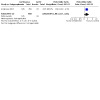
Comparison 1: 30 ug ethinyl estradiol and 150 ug levonorgestrel, 28‐day versus 91‐day cycles for one year, Outcome 1: Overall Discontinuation
1.2. Analysis.
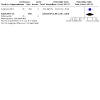
Comparison 1: 30 ug ethinyl estradiol and 150 ug levonorgestrel, 28‐day versus 91‐day cycles for one year, Outcome 2: Discontinuation for bleeding reasons
1.3. Analysis.
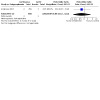
Comparison 1: 30 ug ethinyl estradiol and 150 ug levonorgestrel, 28‐day versus 91‐day cycles for one year, Outcome 3: Pregnancy
1.4. Analysis.
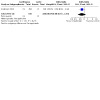
Comparison 1: 30 ug ethinyl estradiol and 150 ug levonorgestrel, 28‐day versus 91‐day cycles for one year, Outcome 4: Overall adherence based on self reported diary
1.5. Analysis.
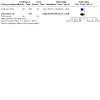
Comparison 1: 30 ug ethinyl estradiol and 150 ug levonorgestrel, 28‐day versus 91‐day cycles for one year, Outcome 5: Symptoms: Headache
1.6. Analysis.
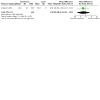
Comparison 1: 30 ug ethinyl estradiol and 150 ug levonorgestrel, 28‐day versus 91‐day cycles for one year, Outcome 6: Mean total bleeding days (bleeding + spotting) for entire study period (364 days)
1.7. Analysis.
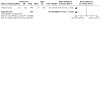
Comparison 1: 30 ug ethinyl estradiol and 150 ug levonorgestrel, 28‐day versus 91‐day cycles for one year, Outcome 7: Mean bleeding days only for entire study period (364 days)
Comparison 2. 30 ug ethinyl estradiol and 150 ug desogestrel, 28‐day versus 70‐day cycles for one year.
| Outcome or subgroup title | No. of studies | No. of participants | Statistical method | Effect size |
|---|---|---|---|---|
| 2.1 Overall discontinuation | 1 | 294 | Peto Odds Ratio (Peto, Fixed, 95% CI) | 1.43 [0.87, 2.36] |
| 2.2 Discontinuation for bleeding reasons | 1 | 294 | Peto Odds Ratio (Peto, Fixed, 95% CI) | 3.59 [1.57, 8.22] |
| 2.3 Pregnancy | 1 | 294 | Peto Odds Ratio (Peto, Fixed, 95% CI) | Not estimable |
2.1. Analysis.
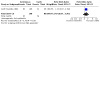
Comparison 2: 30 ug ethinyl estradiol and 150 ug desogestrel, 28‐day versus 70‐day cycles for one year, Outcome 1: Overall discontinuation
2.2. Analysis.
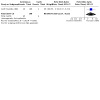
Comparison 2: 30 ug ethinyl estradiol and 150 ug desogestrel, 28‐day versus 70‐day cycles for one year, Outcome 2: Discontinuation for bleeding reasons
2.3. Analysis.
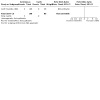
Comparison 2: 30 ug ethinyl estradiol and 150 ug desogestrel, 28‐day versus 70‐day cycles for one year, Outcome 3: Pregnancy
Comparison 3. 50 ug ethinyl estradiol and 250 ug levonorgestrel, 28‐days versus 1 year cycles for one year, dosed vaginally.
| Outcome or subgroup title | No. of studies | No. of participants | Statistical method | Effect size |
|---|---|---|---|---|
| 3.1 Overall discontinuation | 1 | 900 | Peto Odds Ratio (Peto, Fixed, 95% CI) | 1.02 [0.70, 1.49] |
| 3.2 Discontinuation for bleeding reasons | 1 | 900 | Peto Odds Ratio (Peto, Fixed, 95% CI) | 1.27 [0.34, 4.73] |
| 3.3 Pregnancy | 1 | 900 | Peto Odds Ratio (Peto, Fixed, 95% CI) | 0.14 [0.02, 0.97] |
| 3.4 Mean of total bleeding days (bleeding + spotting) in first trimester (90 days) | 1 | 722 | Mean Difference (IV, Fixed, 95% CI) | ‐10.66 [‐11.28, ‐10.04] |
| 3.5 Mean of total bleeding days (bleeding + spotting) in second trimester (90 days) | 1 | 670 | Mean Difference (IV, Fixed, 95% CI) | ‐11.79 [‐12.44, ‐11.14] |
| 3.6 Mean of total bleeding days (bleeding + spotting) in third trimester (90 days) | 1 | 606 | Mean Difference (IV, Fixed, 95% CI) | ‐12.43 [‐12.86, ‐12.00] |
| 3.7 Mean of total bleeding days (bleeding + spotting) in fourth trimester (90 days) | 1 | 339 | Mean Difference (IV, Fixed, 95% CI) | ‐11.86 [‐12.46, ‐11.26] |
3.1. Analysis.
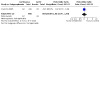
Comparison 3: 50 ug ethinyl estradiol and 250 ug levonorgestrel, 28‐days versus 1 year cycles for one year, dosed vaginally, Outcome 1: Overall discontinuation
3.2. Analysis.
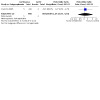
Comparison 3: 50 ug ethinyl estradiol and 250 ug levonorgestrel, 28‐days versus 1 year cycles for one year, dosed vaginally, Outcome 2: Discontinuation for bleeding reasons
3.3. Analysis.
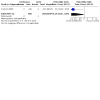
Comparison 3: 50 ug ethinyl estradiol and 250 ug levonorgestrel, 28‐days versus 1 year cycles for one year, dosed vaginally, Outcome 3: Pregnancy
3.4. Analysis.
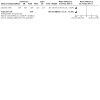
Comparison 3: 50 ug ethinyl estradiol and 250 ug levonorgestrel, 28‐days versus 1 year cycles for one year, dosed vaginally, Outcome 4: Mean of total bleeding days (bleeding + spotting) in first trimester (90 days)
3.5. Analysis.
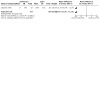
Comparison 3: 50 ug ethinyl estradiol and 250 ug levonorgestrel, 28‐days versus 1 year cycles for one year, dosed vaginally, Outcome 5: Mean of total bleeding days (bleeding + spotting) in second trimester (90 days)
3.6. Analysis.
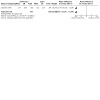
Comparison 3: 50 ug ethinyl estradiol and 250 ug levonorgestrel, 28‐days versus 1 year cycles for one year, dosed vaginally, Outcome 6: Mean of total bleeding days (bleeding + spotting) in third trimester (90 days)
3.7. Analysis.

Comparison 3: 50 ug ethinyl estradiol and 250 ug levonorgestrel, 28‐days versus 1 year cycles for one year, dosed vaginally, Outcome 7: Mean of total bleeding days (bleeding + spotting) in fourth trimester (90 days)
Comparison 4. 20 ug ethinyl estradiol and 100 ug levonorgestrel, 28‐day versus 168‐day cycles for 6 months.
| Outcome or subgroup title | No. of studies | No. of participants | Statistical method | Effect size |
|---|---|---|---|---|
| 4.1 Overall discontinuation | 1 | 32 | Peto Odds Ratio (Peto, Fixed, 95% CI) | 0.33 [0.04, 2.60] |
| 4.2 Discontinuation for bleeding reasons | 1 | 32 | Peto Odds Ratio (Peto, Fixed, 95% CI) | 7.39 [0.15, 372.38] |
| 4.3 Pregnancy | 1 | 32 | Peto Odds Ratio (Peto, Fixed, 95% CI) | Not estimable |
| 4.4 Mean of total bleeding days (bleeding + spotting) in first trimester (84 days) | 1 | 28 | Mean Difference (IV, Fixed, 95% CI) | ‐4.33 [‐12.27, 3.61] |
| 4.5 Mean of total bleeding days (bleeding + spotting) in second trimester (84 days) | 1 | 27 | Mean Difference (IV, Fixed, 95% CI) | ‐3.90 [‐15.66, 7.86] |
| 4.6 Mean spotting days in the first trimester (84 days) | 1 | 28 | Mean Difference (IV, Fixed, 95% CI) | 3.55 [‐1.71, 8.81] |
| 4.7 Mean spotting days in second trimester (84 days) | 1 | 27 | Mean Difference (IV, Fixed, 95% CI) | 4.82 [‐5.76, 15.40] |
| 4.8 Mean bleeding days in first trimester (84 days) | 1 | 28 | Mean Difference (IV, Fixed, 95% CI) | ‐7.73 [‐13.97, ‐1.49] |
| 4.9 Mean bleeding days in second trimester (84 days) | 1 | 27 | Mean Difference (IV, Fixed, 95% CI) | ‐8.86 [‐12.82, ‐4.90] |
| 4.10 Symptoms: total number of bloating days | 1 | 27 | Mean Difference (IV, Fixed, 95% CI) | ‐10.99 [‐19.77, ‐2.21] |
| 4.11 Symptoms: total number of "menstrual pain" days | 1 | 27 | Mean Difference (IV, Fixed, 95% CI) | ‐11.45 [‐18.40, ‐4.50] |
4.1. Analysis.
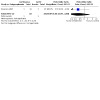
Comparison 4: 20 ug ethinyl estradiol and 100 ug levonorgestrel, 28‐day versus 168‐day cycles for 6 months, Outcome 1: Overall discontinuation
4.2. Analysis.
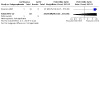
Comparison 4: 20 ug ethinyl estradiol and 100 ug levonorgestrel, 28‐day versus 168‐day cycles for 6 months, Outcome 2: Discontinuation for bleeding reasons
4.3. Analysis.
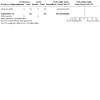
Comparison 4: 20 ug ethinyl estradiol and 100 ug levonorgestrel, 28‐day versus 168‐day cycles for 6 months, Outcome 3: Pregnancy
4.4. Analysis.
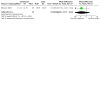
Comparison 4: 20 ug ethinyl estradiol and 100 ug levonorgestrel, 28‐day versus 168‐day cycles for 6 months, Outcome 4: Mean of total bleeding days (bleeding + spotting) in first trimester (84 days)
4.5. Analysis.
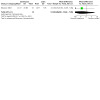
Comparison 4: 20 ug ethinyl estradiol and 100 ug levonorgestrel, 28‐day versus 168‐day cycles for 6 months, Outcome 5: Mean of total bleeding days (bleeding + spotting) in second trimester (84 days)
4.6. Analysis.
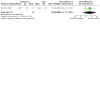
Comparison 4: 20 ug ethinyl estradiol and 100 ug levonorgestrel, 28‐day versus 168‐day cycles for 6 months, Outcome 6: Mean spotting days in the first trimester (84 days)
4.7. Analysis.
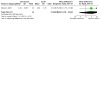
Comparison 4: 20 ug ethinyl estradiol and 100 ug levonorgestrel, 28‐day versus 168‐day cycles for 6 months, Outcome 7: Mean spotting days in second trimester (84 days)
4.8. Analysis.
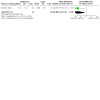
Comparison 4: 20 ug ethinyl estradiol and 100 ug levonorgestrel, 28‐day versus 168‐day cycles for 6 months, Outcome 8: Mean bleeding days in first trimester (84 days)
4.9. Analysis.
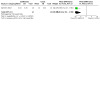
Comparison 4: 20 ug ethinyl estradiol and 100 ug levonorgestrel, 28‐day versus 168‐day cycles for 6 months, Outcome 9: Mean bleeding days in second trimester (84 days)
4.10. Analysis.
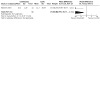
Comparison 4: 20 ug ethinyl estradiol and 100 ug levonorgestrel, 28‐day versus 168‐day cycles for 6 months, Outcome 10: Symptoms: total number of bloating days
4.11. Analysis.
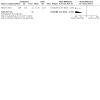
Comparison 4: 20 ug ethinyl estradiol and 100 ug levonorgestrel, 28‐day versus 168‐day cycles for 6 months, Outcome 11: Symptoms: total number of "menstrual pain" days
Comparison 5. 30 ug ethinyl estradiol and 300 ug norgestrel, 28‐day versus 49‐day cycles for one year.
| Outcome or subgroup title | No. of studies | No. of participants | Statistical method | Effect size |
|---|---|---|---|---|
| 5.1 Overall discontinuation | 1 | 90 | Peto Odds Ratio (Peto, Fixed, 95% CI) | 0.71 [0.31, 1.63] |
| 5.2 Discontinuation for bleeding reasons | 1 | 90 | Peto Odds Ratio (Peto, Fixed, 95% CI) | 0.96 [0.06, 15.54] |
| 5.3 Pregnancy | 1 | 90 | Peto Odds Ratio (Peto, Fixed, 95% CI) | 0.96 [0.13, 7.02] |
| 5.4 Mean spotting days in first trimester (84 days) | 1 | 56 | Mean Difference (IV, Fixed, 95% CI) | ‐1.10 [‐3.04, 0.84] |
| 5.5 Mean spotting days in second trimester (84 days) | 1 | 55 | Mean Difference (IV, Fixed, 95% CI) | ‐0.90 [‐2.36, 0.56] |
| 5.6 Mean spotting days in third trimester (84 days) | 1 | 49 | Mean Difference (IV, Fixed, 95% CI) | 0.50 [‐1.93, 2.93] |
| 5.7 Mean spotting days in fourth trimester (84 days) | 1 | 43 | Mean Difference (IV, Fixed, 95% CI) | ‐0.50 [‐2.56, 1.56] |
| 5.8 Mean bleeding days in first trimester (84 days) | 1 | 56 | Mean Difference (IV, Fixed, 95% CI) | ‐4.50 [‐7.11, ‐1.89] |
| 5.9 Mean bleeding days in second trimester (84 days) | 1 | 55 | Mean Difference (IV, Fixed, 95% CI) | ‐2.40 [‐4.65, ‐0.15] |
| 5.10 Mean bleeding days in third trimester (84 days) | 1 | 49 | Mean Difference (IV, Fixed, 95% CI) | ‐3.90 [‐6.76, ‐1.04] |
| 5.11 Mean bleeding days in fourth trimester | 1 | 43 | Mean Difference (IV, Fixed, 95% CI) | ‐5.50 [‐10.52, ‐0.48] |
5.1. Analysis.
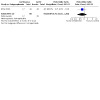
Comparison 5: 30 ug ethinyl estradiol and 300 ug norgestrel, 28‐day versus 49‐day cycles for one year, Outcome 1: Overall discontinuation
5.2. Analysis.
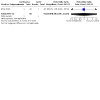
Comparison 5: 30 ug ethinyl estradiol and 300 ug norgestrel, 28‐day versus 49‐day cycles for one year, Outcome 2: Discontinuation for bleeding reasons
5.3. Analysis.
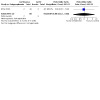
Comparison 5: 30 ug ethinyl estradiol and 300 ug norgestrel, 28‐day versus 49‐day cycles for one year, Outcome 3: Pregnancy
5.4. Analysis.
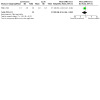
Comparison 5: 30 ug ethinyl estradiol and 300 ug norgestrel, 28‐day versus 49‐day cycles for one year, Outcome 4: Mean spotting days in first trimester (84 days)
5.5. Analysis.

Comparison 5: 30 ug ethinyl estradiol and 300 ug norgestrel, 28‐day versus 49‐day cycles for one year, Outcome 5: Mean spotting days in second trimester (84 days)
5.6. Analysis.
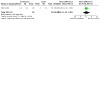
Comparison 5: 30 ug ethinyl estradiol and 300 ug norgestrel, 28‐day versus 49‐day cycles for one year, Outcome 6: Mean spotting days in third trimester (84 days)
5.7. Analysis.
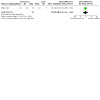
Comparison 5: 30 ug ethinyl estradiol and 300 ug norgestrel, 28‐day versus 49‐day cycles for one year, Outcome 7: Mean spotting days in fourth trimester (84 days)
5.8. Analysis.
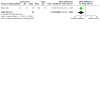
Comparison 5: 30 ug ethinyl estradiol and 300 ug norgestrel, 28‐day versus 49‐day cycles for one year, Outcome 8: Mean bleeding days in first trimester (84 days)
5.9. Analysis.
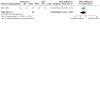
Comparison 5: 30 ug ethinyl estradiol and 300 ug norgestrel, 28‐day versus 49‐day cycles for one year, Outcome 9: Mean bleeding days in second trimester (84 days)
5.10. Analysis.
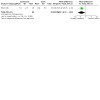
Comparison 5: 30 ug ethinyl estradiol and 300 ug norgestrel, 28‐day versus 49‐day cycles for one year, Outcome 10: Mean bleeding days in third trimester (84 days)
5.11. Analysis.
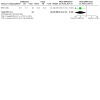
Comparison 5: 30 ug ethinyl estradiol and 300 ug norgestrel, 28‐day versus 49‐day cycles for one year, Outcome 11: Mean bleeding days in fourth trimester
Comparison 6. 20 ug ethinyl estradiol and 100 ug levonorgestrel, 28‐day versus 336‐day cycles for one year.
| Outcome or subgroup title | No. of studies | No. of participants | Statistical method | Effect size |
|---|---|---|---|---|
| 6.1 Overall discontinuation | 1 | 79 | Peto Odds Ratio (Peto, Fixed, 95% CI) | 0.52 [0.19, 1.45] |
| 6.2 Discontinuation for bleeding reasons | 1 | 79 | Peto Odds Ratio (Peto, Fixed, 95% CI) | 1.57 [0.26, 9.47] |
| 6.3 Pregnancy | 1 | 79 | Peto Odds Ratio (Peto, Fixed, 95% CI) | Not estimable |
| 6.4 Mean of total bleeding days (bleeding + spotting) in first trimester (84 days) | 1 | 73 | Mean Difference (IV, Fixed, 95% CI) | 0.70 [‐4.22, 5.62] |
| 6.5 Mean of total bleeding days (bleeding + spotting) in second trimester (84 days) | 1 | 64 | Mean Difference (IV, Fixed, 95% CI) | 1.40 [‐5.55, 8.35] |
| 6.6 Mean of total bleeding days (bleeding + spotting) in third trimester (84 days) | 1 | 61 | Mean Difference (IV, Fixed, 95% CI) | ‐3.80 [‐10.59, 2.99] |
| 6.7 Mean of total bleeding days (bleeding + spotting) in fourth trimester (84 days) | 1 | 60 | Mean Difference (IV, Fixed, 95% CI) | ‐3.20 [‐10.48, 4.08] |
| 6.8 Mean spotting days in first trimester | 1 | 73 | Mean Difference (IV, Fixed, 95% CI) | 4.50 [1.00, 8.00] |
| 6.9 Mean spotting days in second trimester | 1 | 64 | Mean Difference (IV, Fixed, 95% CI) | 6.90 [1.43, 12.37] |
| 6.10 Mean spotting days in third trimester | 1 | 61 | Mean Difference (IV, Fixed, 95% CI) | 2.60 [‐2.04, 7.24] |
| 6.11 Mean spotting days in fourth trimester | 1 | 60 | Mean Difference (IV, Fixed, 95% CI) | 5.60 [‐0.94, 12.14] |
| 6.12 Mean bleeding days in first trimester | 1 | 73 | Mean Difference (IV, Fixed, 95% CI) | ‐3.80 [‐7.29, ‐0.31] |
| 6.13 Mean bleeding days in second trimester | 1 | 64 | Mean Difference (IV, Fixed, 95% CI) | ‐5.40 [‐8.87, ‐1.93] |
| 6.14 Mean bleeding days in third trimester | 1 | 61 | Mean Difference (IV, Fixed, 95% CI) | ‐6.30 [‐10.15, ‐2.45] |
| 6.15 Mean bleeding days in fourth trimester | 1 | 60 | Mean Difference (IV, Fixed, 95% CI) | ‐8.80 [‐11.01, ‐6.59] |
| 6.16 Symptoms: headache | 1 | 79 | Peto Odds Ratio (Peto, Fixed, 95% CI) | 0.18 [0.05, 0.72] |
| 6.17 Symptoms: mood changes | 1 | 79 | Peto Odds Ratio (Peto, Fixed, 95% CI) | 0.13 [0.01, 1.30] |
6.1. Analysis.

Comparison 6: 20 ug ethinyl estradiol and 100 ug levonorgestrel, 28‐day versus 336‐day cycles for one year, Outcome 1: Overall discontinuation
6.2. Analysis.
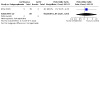
Comparison 6: 20 ug ethinyl estradiol and 100 ug levonorgestrel, 28‐day versus 336‐day cycles for one year, Outcome 2: Discontinuation for bleeding reasons
6.3. Analysis.
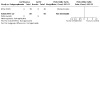
Comparison 6: 20 ug ethinyl estradiol and 100 ug levonorgestrel, 28‐day versus 336‐day cycles for one year, Outcome 3: Pregnancy
6.4. Analysis.
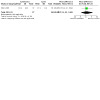
Comparison 6: 20 ug ethinyl estradiol and 100 ug levonorgestrel, 28‐day versus 336‐day cycles for one year, Outcome 4: Mean of total bleeding days (bleeding + spotting) in first trimester (84 days)
6.5. Analysis.
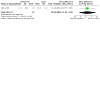
Comparison 6: 20 ug ethinyl estradiol and 100 ug levonorgestrel, 28‐day versus 336‐day cycles for one year, Outcome 5: Mean of total bleeding days (bleeding + spotting) in second trimester (84 days)
6.6. Analysis.
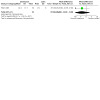
Comparison 6: 20 ug ethinyl estradiol and 100 ug levonorgestrel, 28‐day versus 336‐day cycles for one year, Outcome 6: Mean of total bleeding days (bleeding + spotting) in third trimester (84 days)
6.7. Analysis.
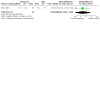
Comparison 6: 20 ug ethinyl estradiol and 100 ug levonorgestrel, 28‐day versus 336‐day cycles for one year, Outcome 7: Mean of total bleeding days (bleeding + spotting) in fourth trimester (84 days)
6.8. Analysis.
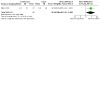
Comparison 6: 20 ug ethinyl estradiol and 100 ug levonorgestrel, 28‐day versus 336‐day cycles for one year, Outcome 8: Mean spotting days in first trimester
6.9. Analysis.
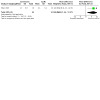
Comparison 6: 20 ug ethinyl estradiol and 100 ug levonorgestrel, 28‐day versus 336‐day cycles for one year, Outcome 9: Mean spotting days in second trimester
6.10. Analysis.
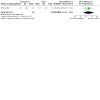
Comparison 6: 20 ug ethinyl estradiol and 100 ug levonorgestrel, 28‐day versus 336‐day cycles for one year, Outcome 10: Mean spotting days in third trimester
6.11. Analysis.
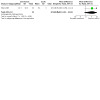
Comparison 6: 20 ug ethinyl estradiol and 100 ug levonorgestrel, 28‐day versus 336‐day cycles for one year, Outcome 11: Mean spotting days in fourth trimester
6.12. Analysis.
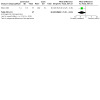
Comparison 6: 20 ug ethinyl estradiol and 100 ug levonorgestrel, 28‐day versus 336‐day cycles for one year, Outcome 12: Mean bleeding days in first trimester
6.13. Analysis.

Comparison 6: 20 ug ethinyl estradiol and 100 ug levonorgestrel, 28‐day versus 336‐day cycles for one year, Outcome 13: Mean bleeding days in second trimester
6.14. Analysis.
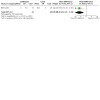
Comparison 6: 20 ug ethinyl estradiol and 100 ug levonorgestrel, 28‐day versus 336‐day cycles for one year, Outcome 14: Mean bleeding days in third trimester
6.15. Analysis.
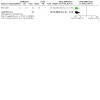
Comparison 6: 20 ug ethinyl estradiol and 100 ug levonorgestrel, 28‐day versus 336‐day cycles for one year, Outcome 15: Mean bleeding days in fourth trimester
6.16. Analysis.
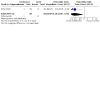
Comparison 6: 20 ug ethinyl estradiol and 100 ug levonorgestrel, 28‐day versus 336‐day cycles for one year, Outcome 16: Symptoms: headache
6.17. Analysis.
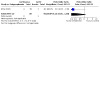
Comparison 6: 20 ug ethinyl estradiol and 100 ug levonorgestrel, 28‐day versus 336‐day cycles for one year, Outcome 17: Symptoms: mood changes
Comparison 7. 15 μg ethinyl estradiol and 120 μg etonogestrel, 28‐day versus 49‐day versus 364‐day cycle. (Contraceptive ring).
| Outcome or subgroup title | No. of studies | No. of participants | Statistical method | Effect size |
|---|---|---|---|---|
| 7.1 Overall discontinuation, 28‐day versus 49‐day | 1 | 215 | Peto Odds Ratio (Peto, Fixed, 95% CI) | 1.29 [0.70, 2.38] |
| 7.2 Overall discontinuation, 28‐day versus 91‐day | 1 | 213 | Peto Odds Ratio (Peto, Fixed, 95% CI) | 2.02 [1.13, 3.61] |
| 7.3 Overall discontinuation, 28‐day versus 364‐day | 1 | 217 | Peto Odds Ratio (Peto, Fixed, 95% CI) | 2.28 [1.29, 4.03] |
| 7.4 Discontinuation for bleeding reasons, 28‐days versus 49‐days | 1 | 215 | Peto Odds Ratio (Peto, Fixed, 95% CI) | 7.75 [1.32, 45.48] |
| 7.5 Discontinuation for bleeding reasons, 28‐day versus 91‐day | 1 | 213 | Peto Odds Ratio (Peto, Fixed, 95% CI) | 8.59 [2.80, 26.30] |
| 7.6 Discontinuation for bleeding reasons, 28‐day versus 364‐day | 1 | 217 | Peto Odds Ratio (Peto, Fixed, 95% CI) | 8.87 [3.54, 22.21] |
| 7.7 Adherence to a 7‐day hormone free interval, 28‐day versus 49‐day | 1 | 215 | Odds Ratio (M‐H, Fixed, 95% CI) | 0.67 [0.11, 4.07] |
| 7.8 Adherence to a 7‐day hormone free interval, 28‐day versus 91‐day | 1 | 213 | Odds Ratio (M‐H, Fixed, 95% CI) | 1.03 [0.20, 5.22] |
| 7.9 Pregnancy, 28‐day versus 91‐day | 1 | 213 | Odds Ratio (M‐H, Fixed, 95% CI) | 3.11 [0.13, 77.33] |
| 7.10 Total bleeding days, 28‐day versus 49‐day | 1 | 77 | Odds Ratio (M‐H, Fixed, 95% CI) | 0.90 [0.26, 3.07] |
| 7.11 Total Bleeding Days, 28‐day versus 91‐day | 1 | 119 | Odds Ratio (M‐H, Fixed, 95% CI) | 1.21 [0.41, 3.61] |
| 7.12 Total bleeding days, 28‐day versus 364‐day | 1 | 392 | Odds Ratio (M‐H, Fixed, 95% CI) | 1.49 [0.55, 4.03] |
7.1. Analysis.
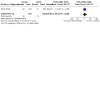
Comparison 7: 15 μg ethinyl estradiol and 120 μg etonogestrel, 28‐day versus 49‐day versus 364‐day cycle. (Contraceptive ring), Outcome 1: Overall discontinuation, 28‐day versus 49‐day
7.2. Analysis.
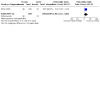
Comparison 7: 15 μg ethinyl estradiol and 120 μg etonogestrel, 28‐day versus 49‐day versus 364‐day cycle. (Contraceptive ring), Outcome 2: Overall discontinuation, 28‐day versus 91‐day
7.3. Analysis.
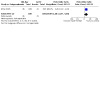
Comparison 7: 15 μg ethinyl estradiol and 120 μg etonogestrel, 28‐day versus 49‐day versus 364‐day cycle. (Contraceptive ring), Outcome 3: Overall discontinuation, 28‐day versus 364‐day
7.4. Analysis.
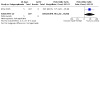
Comparison 7: 15 μg ethinyl estradiol and 120 μg etonogestrel, 28‐day versus 49‐day versus 364‐day cycle. (Contraceptive ring), Outcome 4: Discontinuation for bleeding reasons, 28‐days versus 49‐days
7.5. Analysis.
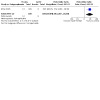
Comparison 7: 15 μg ethinyl estradiol and 120 μg etonogestrel, 28‐day versus 49‐day versus 364‐day cycle. (Contraceptive ring), Outcome 5: Discontinuation for bleeding reasons, 28‐day versus 91‐day
7.6. Analysis.
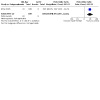
Comparison 7: 15 μg ethinyl estradiol and 120 μg etonogestrel, 28‐day versus 49‐day versus 364‐day cycle. (Contraceptive ring), Outcome 6: Discontinuation for bleeding reasons, 28‐day versus 364‐day
7.7. Analysis.

Comparison 7: 15 μg ethinyl estradiol and 120 μg etonogestrel, 28‐day versus 49‐day versus 364‐day cycle. (Contraceptive ring), Outcome 7: Adherence to a 7‐day hormone free interval, 28‐day versus 49‐day
7.8. Analysis.
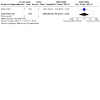
Comparison 7: 15 μg ethinyl estradiol and 120 μg etonogestrel, 28‐day versus 49‐day versus 364‐day cycle. (Contraceptive ring), Outcome 8: Adherence to a 7‐day hormone free interval, 28‐day versus 91‐day
7.9. Analysis.
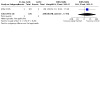
Comparison 7: 15 μg ethinyl estradiol and 120 μg etonogestrel, 28‐day versus 49‐day versus 364‐day cycle. (Contraceptive ring), Outcome 9: Pregnancy, 28‐day versus 91‐day
7.10. Analysis.
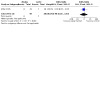
Comparison 7: 15 μg ethinyl estradiol and 120 μg etonogestrel, 28‐day versus 49‐day versus 364‐day cycle. (Contraceptive ring), Outcome 10: Total bleeding days, 28‐day versus 49‐day
7.11. Analysis.
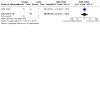
Comparison 7: 15 μg ethinyl estradiol and 120 μg etonogestrel, 28‐day versus 49‐day versus 364‐day cycle. (Contraceptive ring), Outcome 11: Total Bleeding Days, 28‐day versus 91‐day
7.12. Analysis.
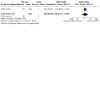
Comparison 7: 15 μg ethinyl estradiol and 120 μg etonogestrel, 28‐day versus 49‐day versus 364‐day cycle. (Contraceptive ring), Outcome 12: Total bleeding days, 28‐day versus 364‐day
Comparison 8. 0.75 mg ethinyl estradiol and 6 mg norelgestromin, 28‐day versus 91‐day cycle. (Contraceptive patch).
| Outcome or subgroup title | No. of studies | No. of participants | Statistical method | Effect size |
|---|---|---|---|---|
| 8.1 Overall Discontinuation | 1 | 235 | Peto Odds Ratio (Peto, Fixed, 95% CI) | 1.45 [0.73, 2.89] |
| 8.2 Discontinuation for bleeding reasons | 1 | 235 | Peto Odds Ratio (Peto, Fixed, 95% CI) | 4.71 [0.85, 25.95] |
| 8.3 Pregnancy | 1 | 235 | Peto Odds Ratio (Peto, Fixed, 95% CI) | 4.55 [0.07, 284.96] |
| 8.4 Adherence | 1 | 235 | Odds Ratio (M‐H, Fixed, 95% CI) | 0.60 [0.30, 1.19] |
| 8.5 Adverse events: headaches | 1 | 235 | Odds Ratio (M‐H, Fixed, 95% CI) | 3.37 [0.96, 11.81] |
| 8.6 Adverse events: nausea | 1 | 235 | Odds Ratio (M‐H, Fixed, 95% CI) | 2.19 [0.71, 6.78] |
| 8.7 Adverse events: breast tenderness | 1 | 235 | Odds Ratio (M‐H, Fixed, 95% CI) | 2.61 [0.95, 7.16] |
| 8.8 % Achieving Amenorrhea, days 1‐84 | 1 | 235 | Odds Ratio (M‐H, Fixed, 95% CI) | 11.04 [1.45, 84.03] |
| 8.9 % Achieving Amenorrhea, day 1‐56 | 1 | 235 | Odds Ratio (M‐H, Fixed, 95% CI) | 30.33 [4.09, 224.88] |
8.1. Analysis.
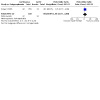
Comparison 8: 0.75 mg ethinyl estradiol and 6 mg norelgestromin, 28‐day versus 91‐day cycle. (Contraceptive patch), Outcome 1: Overall Discontinuation
8.2. Analysis.
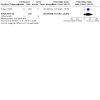
Comparison 8: 0.75 mg ethinyl estradiol and 6 mg norelgestromin, 28‐day versus 91‐day cycle. (Contraceptive patch), Outcome 2: Discontinuation for bleeding reasons
8.3. Analysis.
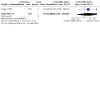
Comparison 8: 0.75 mg ethinyl estradiol and 6 mg norelgestromin, 28‐day versus 91‐day cycle. (Contraceptive patch), Outcome 3: Pregnancy
8.4. Analysis.
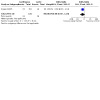
Comparison 8: 0.75 mg ethinyl estradiol and 6 mg norelgestromin, 28‐day versus 91‐day cycle. (Contraceptive patch), Outcome 4: Adherence
8.5. Analysis.
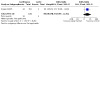
Comparison 8: 0.75 mg ethinyl estradiol and 6 mg norelgestromin, 28‐day versus 91‐day cycle. (Contraceptive patch), Outcome 5: Adverse events: headaches
8.6. Analysis.
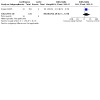
Comparison 8: 0.75 mg ethinyl estradiol and 6 mg norelgestromin, 28‐day versus 91‐day cycle. (Contraceptive patch), Outcome 6: Adverse events: nausea
8.7. Analysis.
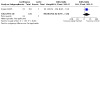
Comparison 8: 0.75 mg ethinyl estradiol and 6 mg norelgestromin, 28‐day versus 91‐day cycle. (Contraceptive patch), Outcome 7: Adverse events: breast tenderness
8.8. Analysis.
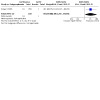
Comparison 8: 0.75 mg ethinyl estradiol and 6 mg norelgestromin, 28‐day versus 91‐day cycle. (Contraceptive patch), Outcome 8: % Achieving Amenorrhea, days 1‐84
8.9. Analysis.

Comparison 8: 0.75 mg ethinyl estradiol and 6 mg norelgestromin, 28‐day versus 91‐day cycle. (Contraceptive patch), Outcome 9: % Achieving Amenorrhea, day 1‐56
Comparison 9. 20 ug ethinyl estradiol and 1 mg norethindrone acetate, 28‐day versus 168‐day cycle for 6 months.
| Outcome or subgroup title | No. of studies | No. of participants | Statistical method | Effect size |
|---|---|---|---|---|
| 9.1 Overall discontinuation | 1 | 62 | Peto Odds Ratio (Peto, Fixed, 95% CI) | 1.24 [0.34, 4.53] |
| 9.2 Mean of total bleeding days (bleeding + spotting) in 168‐day study period | 1 | 51 | Mean Difference (IV, Fixed, 95% CI) | ‐3.60 [‐14.08, 6.88] |
| 9.3 Mean of moderate/heavy bleeding days in 168‐day study period | 1 | 51 | Mean Difference (IV, Fixed, 95% CI) | ‐5.80 [‐10.02, ‐1.58] |
| 9.4 Pregnancy | 1 | 62 | Peto Odds Ratio (Peto, Fixed, 95% CI) | Not estimable |
9.1. Analysis.

Comparison 9: 20 ug ethinyl estradiol and 1 mg norethindrone acetate, 28‐day versus 168‐day cycle for 6 months, Outcome 1: Overall discontinuation
9.2. Analysis.
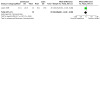
Comparison 9: 20 ug ethinyl estradiol and 1 mg norethindrone acetate, 28‐day versus 168‐day cycle for 6 months, Outcome 2: Mean of total bleeding days (bleeding + spotting) in 168‐day study period
9.3. Analysis.
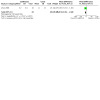
Comparison 9: 20 ug ethinyl estradiol and 1 mg norethindrone acetate, 28‐day versus 168‐day cycle for 6 months, Outcome 3: Mean of moderate/heavy bleeding days in 168‐day study period
9.4. Analysis.
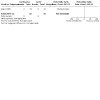
Comparison 9: 20 ug ethinyl estradiol and 1 mg norethindrone acetate, 28‐day versus 168‐day cycle for 6 months, Outcome 4: Pregnancy
Comparison 10. 30 ug ethinyl estradiol and 3 mg drospirenone, 28‐day versus 168‐day cycle for 6 months.
| Outcome or subgroup title | No. of studies | No. of participants | Statistical method | Effect size |
|---|---|---|---|---|
| 10.1 Overall discontinuation | 1 | 78 | Peto Odds Ratio (Peto, Fixed, 95% CI) | 1.15 [0.41, 3.21] |
| 10.2 Pregnancy | 1 | 77 | Peto Odds Ratio (Peto, Fixed, 95% CI) | Not estimable |
| 10.3 Discontinuation for bleeding reasons | 1 | 78 | Peto Odds Ratio (Peto, Fixed, 95% CI) | 8.01 [1.09, 59.17] |
| 10.4 % Achieving Amenorrhea, third 28‐day cycle | 1 | 71 | Odds Ratio (M‐H, Fixed, 95% CI) | 15.16 [3.91, 58.73] |
| 10.5 % Achieving Amenorrhea, sixth 28‐day cycle | 1 | 71 | Odds Ratio (M‐H, Fixed, 95% CI) | 7.67 [2.54, 23.12] |
| 10.6 % With spotting during third 28‐day cycle | 1 | 71 | Odds Ratio (M‐H, Fixed, 95% CI) | 2.07 [0.56, 7.62] |
| 10.7 % With spotting during sixth 28‐day cycle | 1 | 71 | Odds Ratio (M‐H, Fixed, 95% CI) | 2.00 [0.46, 8.72] |
10.1. Analysis.
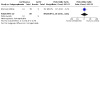
Comparison 10: 30 ug ethinyl estradiol and 3 mg drospirenone, 28‐day versus 168‐day cycle for 6 months, Outcome 1: Overall discontinuation
10.2. Analysis.

Comparison 10: 30 ug ethinyl estradiol and 3 mg drospirenone, 28‐day versus 168‐day cycle for 6 months, Outcome 2: Pregnancy
10.3. Analysis.
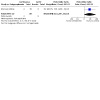
Comparison 10: 30 ug ethinyl estradiol and 3 mg drospirenone, 28‐day versus 168‐day cycle for 6 months, Outcome 3: Discontinuation for bleeding reasons
10.4. Analysis.
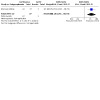
Comparison 10: 30 ug ethinyl estradiol and 3 mg drospirenone, 28‐day versus 168‐day cycle for 6 months, Outcome 4: % Achieving Amenorrhea, third 28‐day cycle
10.5. Analysis.
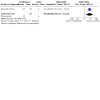
Comparison 10: 30 ug ethinyl estradiol and 3 mg drospirenone, 28‐day versus 168‐day cycle for 6 months, Outcome 5: % Achieving Amenorrhea, sixth 28‐day cycle
10.6. Analysis.

Comparison 10: 30 ug ethinyl estradiol and 3 mg drospirenone, 28‐day versus 168‐day cycle for 6 months, Outcome 6: % With spotting during third 28‐day cycle
10.7. Analysis.
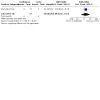
Comparison 10: 30 ug ethinyl estradiol and 3 mg drospirenone, 28‐day versus 168‐day cycle for 6 months, Outcome 7: % With spotting during sixth 28‐day cycle
Comparison 11. 20 ug ethinyl estradiol and 3 mg drospirenone, 28‐day cycle versus flexible regimen (28 to 124‐day cycle) for one year.
| Outcome or subgroup title | No. of studies | No. of participants | Statistical method | Effect size |
|---|---|---|---|---|
| 11.1 Overall discontinuation | 1 | 458 | Peto Odds Ratio (Peto, Fixed, 95% CI) | 1.07 [0.72, 1.59] |
| 11.2 Pregnancy | 1 | 458 | Peto Odds Ratio (Peto, Fixed, 95% CI) | 1.46 [0.25, 8.48] |
| 11.3 Mean of total bleeding days (bleeding + spotting) in first reference period (90 days) | 1 | 345 | Mean Difference (IV, Fixed, 95% CI) | ‐1.20 [‐3.61, 1.21] |
| 11.4 Mean of total bleeding days (bleeding + spotting) in second reference period (90 days) | 1 | 306 | Mean Difference (IV, Fixed, 95% CI) | ‐2.30 [‐4.38, ‐0.22] |
| 11.5 Mean of total bleeding days (bleeding + spotting) in third reference period (90 days) | 1 | 287 | Mean Difference (IV, Fixed, 95% CI) | ‐3.40 [‐5.58, ‐1.22] |
| 11.6 Mean of total bleeding days (bleeding + spotting) in fourth reference period (90 days) | 1 | 255 | Mean Difference (IV, Fixed, 95% CI) | ‐4.10 [‐6.26, ‐1.94] |
| 11.7 Mean spotting days in first reference period | 1 | 345 | Mean Difference (IV, Fixed, 95% CI) | 2.20 [0.57, 3.83] |
| 11.8 Mean spotting days in second reference period | 1 | 306 | Mean Difference (IV, Fixed, 95% CI) | 2.00 [0.62, 3.38] |
| 11.9 Mean spotting days in third reference period | 1 | 287 | Mean Difference (IV, Fixed, 95% CI) | 1.10 [‐0.40, 2.60] |
| 11.10 Mean spotting days in fourth reference period | 1 | 255 | Mean Difference (IV, Fixed, 95% CI) | 0.30 [‐1.34, 1.94] |
| 11.11 Mean bleeding days in first reference period | 1 | 345 | Mean Difference (IV, Fixed, 95% CI) | ‐3.50 [‐4.95, ‐2.05] |
| 11.12 Mean bleeding days in second reference period | 1 | 306 | Mean Difference (IV, Fixed, 95% CI) | ‐4.30 [‐5.63, ‐2.97] |
| 11.13 Mean bleeding days in third reference period | 1 | 287 | Mean Difference (IV, Fixed, 95% CI) | ‐4.50 [‐5.86, ‐3.14] |
| 11.14 Mean bleeding days in fourth reference period | 1 | 255 | Mean Difference (IV, Fixed, 95% CI) | ‐4.40 [‐5.69, ‐3.11] |
11.1. Analysis.
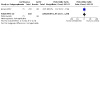
Comparison 11: 20 ug ethinyl estradiol and 3 mg drospirenone, 28‐day cycle versus flexible regimen (28 to 124‐day cycle) for one year, Outcome 1: Overall discontinuation
11.2. Analysis.
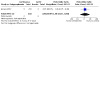
Comparison 11: 20 ug ethinyl estradiol and 3 mg drospirenone, 28‐day cycle versus flexible regimen (28 to 124‐day cycle) for one year, Outcome 2: Pregnancy
11.3. Analysis.
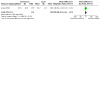
Comparison 11: 20 ug ethinyl estradiol and 3 mg drospirenone, 28‐day cycle versus flexible regimen (28 to 124‐day cycle) for one year, Outcome 3: Mean of total bleeding days (bleeding + spotting) in first reference period (90 days)
11.4. Analysis.
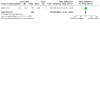
Comparison 11: 20 ug ethinyl estradiol and 3 mg drospirenone, 28‐day cycle versus flexible regimen (28 to 124‐day cycle) for one year, Outcome 4: Mean of total bleeding days (bleeding + spotting) in second reference period (90 days)
11.5. Analysis.
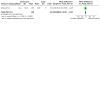
Comparison 11: 20 ug ethinyl estradiol and 3 mg drospirenone, 28‐day cycle versus flexible regimen (28 to 124‐day cycle) for one year, Outcome 5: Mean of total bleeding days (bleeding + spotting) in third reference period (90 days)
11.6. Analysis.
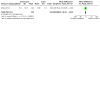
Comparison 11: 20 ug ethinyl estradiol and 3 mg drospirenone, 28‐day cycle versus flexible regimen (28 to 124‐day cycle) for one year, Outcome 6: Mean of total bleeding days (bleeding + spotting) in fourth reference period (90 days)
11.7. Analysis.
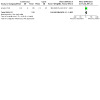
Comparison 11: 20 ug ethinyl estradiol and 3 mg drospirenone, 28‐day cycle versus flexible regimen (28 to 124‐day cycle) for one year, Outcome 7: Mean spotting days in first reference period
11.8. Analysis.
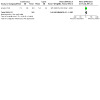
Comparison 11: 20 ug ethinyl estradiol and 3 mg drospirenone, 28‐day cycle versus flexible regimen (28 to 124‐day cycle) for one year, Outcome 8: Mean spotting days in second reference period
11.9. Analysis.
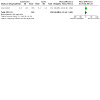
Comparison 11: 20 ug ethinyl estradiol and 3 mg drospirenone, 28‐day cycle versus flexible regimen (28 to 124‐day cycle) for one year, Outcome 9: Mean spotting days in third reference period
11.10. Analysis.
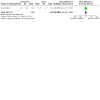
Comparison 11: 20 ug ethinyl estradiol and 3 mg drospirenone, 28‐day cycle versus flexible regimen (28 to 124‐day cycle) for one year, Outcome 10: Mean spotting days in fourth reference period
11.11. Analysis.
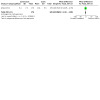
Comparison 11: 20 ug ethinyl estradiol and 3 mg drospirenone, 28‐day cycle versus flexible regimen (28 to 124‐day cycle) for one year, Outcome 11: Mean bleeding days in first reference period
11.12. Analysis.
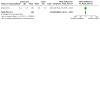
Comparison 11: 20 ug ethinyl estradiol and 3 mg drospirenone, 28‐day cycle versus flexible regimen (28 to 124‐day cycle) for one year, Outcome 12: Mean bleeding days in second reference period
11.13. Analysis.
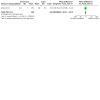
Comparison 11: 20 ug ethinyl estradiol and 3 mg drospirenone, 28‐day cycle versus flexible regimen (28 to 124‐day cycle) for one year, Outcome 13: Mean bleeding days in third reference period
11.14. Analysis.
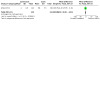
Comparison 11: 20 ug ethinyl estradiol and 3 mg drospirenone, 28‐day cycle versus flexible regimen (28 to 124‐day cycle) for one year, Outcome 14: Mean bleeding days in fourth reference period
Comparison 12. 30 ug ethinyl estradiol and 150 ug levonorgestrel, 28‐day cycle versus tailored regimen (3‐day pill‐free interval initiated after 3 days of bleeding) for one year.
| Outcome or subgroup title | No. of studies | No. of participants | Statistical method | Effect size |
|---|---|---|---|---|
| 12.1 Overall discontinuation of COC (including loss to follow up) | 1 | 503 | Peto Odds Ratio (Peto, Fixed, 95% CI) | 0.91 [0.64, 1.30] |
| 12.2 Discontinuation of allocated COC regimen (including loss to follow up) | 1 | 503 | Peto Odds Ratio (Peto, Fixed, 95% CI) | 1.40 [0.98, 1.99] |
| 12.3 Discontinuation for bleeding reasons | 1 | 503 | Peto Odds Ratio (Peto, Fixed, 95% CI) | 3.79 [1.75, 8.22] |
| 12.4 Pregnancy | 1 | 356 | Peto Odds Ratio (Peto, Fixed, 95% CI) | 7.35 [0.46, 117.94] |
| 12.5 Mean number of bleeding episodes per month | 1 | 261 | Mean Difference (IV, Fixed, 95% CI) | ‐0.50 [‐0.60, ‐0.40] |
| 12.6 Symptoms: headaches | 1 | 248 | Peto Odds Ratio (Peto, Fixed, 95% CI) | 0.64 [0.28, 1.43] |
| 12.7 Symptoms: breast tenderness | 1 | 248 | Peto Odds Ratio (Peto, Fixed, 95% CI) | 1.54 [0.56, 4.23] |
| 12.8 Symptoms: feeling bloated | 1 | 248 | Peto Odds Ratio (Peto, Fixed, 95% CI) | 1.25 [0.61, 2.54] |
12.1. Analysis.
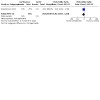
Comparison 12: 30 ug ethinyl estradiol and 150 ug levonorgestrel, 28‐day cycle versus tailored regimen (3‐day pill‐free interval initiated after 3 days of bleeding) for one year, Outcome 1: Overall discontinuation of COC (including loss to follow up)
12.2. Analysis.

Comparison 12: 30 ug ethinyl estradiol and 150 ug levonorgestrel, 28‐day cycle versus tailored regimen (3‐day pill‐free interval initiated after 3 days of bleeding) for one year, Outcome 2: Discontinuation of allocated COC regimen (including loss to follow up)
12.3. Analysis.
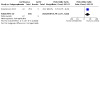
Comparison 12: 30 ug ethinyl estradiol and 150 ug levonorgestrel, 28‐day cycle versus tailored regimen (3‐day pill‐free interval initiated after 3 days of bleeding) for one year, Outcome 3: Discontinuation for bleeding reasons
12.4. Analysis.

Comparison 12: 30 ug ethinyl estradiol and 150 ug levonorgestrel, 28‐day cycle versus tailored regimen (3‐day pill‐free interval initiated after 3 days of bleeding) for one year, Outcome 4: Pregnancy
12.5. Analysis.
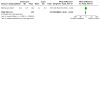
Comparison 12: 30 ug ethinyl estradiol and 150 ug levonorgestrel, 28‐day cycle versus tailored regimen (3‐day pill‐free interval initiated after 3 days of bleeding) for one year, Outcome 5: Mean number of bleeding episodes per month
12.6. Analysis.
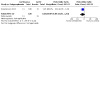
Comparison 12: 30 ug ethinyl estradiol and 150 ug levonorgestrel, 28‐day cycle versus tailored regimen (3‐day pill‐free interval initiated after 3 days of bleeding) for one year, Outcome 6: Symptoms: headaches
12.7. Analysis.

Comparison 12: 30 ug ethinyl estradiol and 150 ug levonorgestrel, 28‐day cycle versus tailored regimen (3‐day pill‐free interval initiated after 3 days of bleeding) for one year, Outcome 7: Symptoms: breast tenderness
12.8. Analysis.
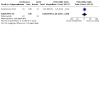
Comparison 12: 30 ug ethinyl estradiol and 150 ug levonorgestrel, 28‐day cycle versus tailored regimen (3‐day pill‐free interval initiated after 3 days of bleeding) for one year, Outcome 8: Symptoms: feeling bloated
Characteristics of studies
Characteristics of included studies [ordered by study ID]
Anderson 2003.
| Study characteristics | ||
| Methods | Randomized clinical trial. Open label. Multicentered trial (47 U.S. sites). Funded by Barr. | |
| Participants | Age: 18‐40 years old. English speaking At risk for pregnancy. No COC contraindications | |
| Interventions | 28‐day (21 days with 7‐day hormone free interval; N=226) versus 91‐day (84 days followed by 7‐day hormone free interval; N=456) cycles for 1 year. 150 mcg levonorgestrel and 30 mcg of ethinyl estradiol | |
| Outcomes | Compliance, bleeding profiles, patient acceptance | |
| Notes | Computer‐generated randomization through a treatment allocation center. Bleeding definitions: spotting requires no protection and bleeding requires protection. Analysis in 364‐day blocks | |
| Risk of bias | ||
| Bias | Authors' judgement | Support for judgement |
| Allocation concealment (selection bias) | Low risk | A ‐ Adequate |
Cachrimanidou 1993.
| Study characteristics | ||
| Methods | Randomized clinical trial. Three centers in Sweden. Unblinded participants and investigators. Funded by Organon. | |
| Participants | Age: 18‐39 years old. At risk for pregnancy. No COC contraindications | |
| Interventions | 28‐day (21 days with 7‐day hormone free interval; N=96) versus 70‐day (63 days with 7‐day hormone free interval; N=198) cycles for 1 year. 150 mcg desogestrel and 30 mcg ethinyl estradiol | |
| Outcomes | Body weight, blood pressure, bleeding profiles, satisfaction | |
| Notes | Inclusion and exclusion criteria were unclear. Method of randomization not reported. Sealed envelopes for allocation. No power calculation included. Bleeding definitions: spotting does not require protection or at most one pad/day, bleeding requires at least 2 pads/day. Analysis in 70‐day blocks for continuous dosing and 84‐day blocks for cyclic. | |
| Risk of bias | ||
| Bias | Authors' judgement | Support for judgement |
| Allocation concealment (selection bias) | Unclear risk | B ‐ Unclear |
Coutinho 1995.
| Study characteristics | ||
| Methods | Randomized clinical trial. Open label. Multicentered trial in Brazil, China, Egypt. Vaginal dosing of medications. No external funding. | |
| Participants | Reproductive age (otherwise no inclusion/exclusion criteria listed) | |
| Interventions | 28‐day (21 days with 7‐day hormone free interval; N=454) versus 1 year (N=446) cycles for 1 year. Vaginal dosing of 250 mcg levonorgestrel and 50 mcg ethinyl estradiol | |
| Outcomes | Bleeding profile, side effects, weight, blood pressure, red blood cell count, hematocrit, hemoglobin. | |
| Notes | Computer‐generated randomization. Bleeding definition: spotting requires no protection and bleeding requires protection. Analysis of bleeding in 90 day blocks. Standard error reported for mean number of bleeding/spotting days, however it appears to be standard deviation and was used that way in this analysis. No power calculation included. | |
| Risk of bias | ||
| Bias | Authors' judgement | Support for judgement |
| Allocation concealment (selection bias) | Unclear risk | B ‐ Unclear |
Jensen 2012.
| Study characteristics | ||
| Methods | Randomized clinical trial. Open label. Multicentered trial (84 U.S. sites). Funded by Bayer. | |
| Participants | Age: 18‐45 years old No COC contraindications Regular menstrual cycles No history of infertility Normal pap BMI up to 35 kg/m2 |
|
| Interventions | Flexible regimen (continuous for at least 24 days, with 4‐day hormone free interval initiated anytime from cycle day 25‐120; N = 234) versus 28‐day cycles (24 days with a 4‐day hormone free interval; N = 232). 3 mg drospirenone and 20 mcg ethinyl estradiol | |
| Outcomes | Bleeding profile, contraceptive efficacy, satisfaction, safety | |
| Notes | Computer‐generated randomization (blocks of 6). Bleeding defined using WHO criteria. Power analysis included. Power analysis included. | |
| Risk of bias | ||
| Bias | Authors' judgement | Support for judgement |
| Allocation concealment (selection bias) | Low risk | A ‐ Adequate |
Kwiecien 2003.
| Study characteristics | ||
| Methods | Randomized clinical trial. Open label. One center in Portland, Oregon. No external funding. | |
| Participants | Age: 18‐50 years old No COC contraindications | |
| Interventions | 28‐day (21 days with 7‐day hormone free interval; N=16) versus 168‐day (N=16) cycles for 6 months. 100 mcg levonorgestrel and 20 mcg ethinyl estradiol | |
| Outcomes | Bleeding days, amenorrhea, side effects, menstrual‐related symptoms, satisfaction, endometrial stripe by transvaginal ultrasound. | |
| Notes | Computer‐generated randomization. Sealed opaque envelopes for allocation. Bleeding definitions: spotting defined as no protection needed, bleeding as needing sanitary protection. Analysis of bleeding in 28‐day blocks. Satisfaction reported by 100 mm scale. Power calculation included | |
| Risk of bias | ||
| Bias | Authors' judgement | Support for judgement |
| Allocation concealment (selection bias) | Low risk | A ‐ Adequate |
Legro 2008.
| Study characteristics | ||
| Methods | Randomized double‐blind clinical trial. One center in Hershey, Pennsylvania. No external funding. | |
| Participants | Nonsmoking women.
No COC contraindications. Normal menstrual cycles 21‐35 day length for three months. No hormonal contraceptives for three months. |
|
| Interventions | 28‐day (21 days with 7‐day hormone free interval; N=31) versus 168‐day (N=31) cycles for 6 months. 1 mg norethindrone acetate and 20 mcg ethinyl estradiol | |
| Outcomes | Bleeding profile; serum and urine assays for sex steroids, gonadotropins, insulin, glucose, lipids, SHBG, hemoglobin, hematocrit; total ovarian volume and endometrial thickness on transvaginal ultrasound, endometrial biopsy, menstrual symptoms, weight, blood pressure. | |
| Notes | Computer‐generated randomization (blocks of 6). Allocation concealment not noted. Subjects and investigators were blinded by over‐encapsulating the pills during the fourth week of the cycle. Bleeding/spotting not specifically defined. Bleeding outcomes on a Likert scale. Analysis of bleeding in 28‐day blocks. Menstrual symptoms per Moos Menstrual Distress Questionnaire. Power calculation included. | |
| Risk of bias | ||
| Bias | Authors' judgement | Support for judgement |
| Allocation concealment (selection bias) | Low risk | A ‐ Adequate |
Machado 2010a.
| Study characteristics | ||
| Methods | Randomized clinical trial. Open label. Three health centers in Brazil. Funded by Libbs. | |
| Participants | Age: 18‐35 years old. At risk for pregnancy. BMI 19‐30 kg/m2. Minimum of 8 years of schooling. No COC contraindications. Normal pap. No hormonal contraceptives for 2 months. |
|
| Interventions | 28‐day (21 days with 7‐day hormone free interval; N=39) versus 168‐day (N=39) cycles for 6 months. 3 mg drospirenone and 30 mcg ethinyl estradiol | |
| Outcomes | Bleeding profile, amenorrhea, menstrual symptoms, weight, blood pressure | |
| Notes | Computer‐generated randomization. Sequentially numbered opaque envelopes. Bleeding definition: spotting requires no protection and bleeding requires protection. Bleeding analysis divided into 28 day blocks. Bleeding intensity by Likert format. Power calculation included. | |
| Risk of bias | ||
| Bias | Authors' judgement | Support for judgement |
| Allocation concealment (selection bias) | Low risk | A ‐ Adequate |
Miller 2001.
| Study characteristics | ||
| Methods | Randomized clinical trial. Open label. Four clinical sites in Seattle, Washington. Funded by ACOG grant. | |
| Participants | Age: 18‐45 years old No COC contraindications Do not desire pregnancy for 1 year | |
| Interventions | 28‐day (21 days with 7‐day hormone free interval; N=44) versus 49‐day (42 days with 7‐day hormone free interval; N=46) cycles for 1 year. 300 mcg norgestrel and 30 mcg ethinyl estradiol | |
| Outcomes | Bleeding profiles, amenorrhea, use of hygiene products, compliance, menstrual symptoms | |
| Notes | Computer‐generated randomization (blocks of 6). Sequentially numbered envelopes with carbon paper inside, opened after the women signed the envelope flap. Bleeding defined as spotting requires no protection and bleeding requires protection. Bleeding analysis divided into 84 day blocks. Satisfaction by Likert format. Power calculation included. | |
| Risk of bias | ||
| Bias | Authors' judgement | Support for judgement |
| Allocation concealment (selection bias) | Low risk | A ‐ Adequate |
Miller 2003.
| Study characteristics | ||
| Methods | Randomized clinical trial. Open label. One site in Seattle, Washington. Funded by Wyeth | |
| Participants | Age: 18‐45 years old No COC contraindications No uterine or cervical abnormalities No use of contraceptive injection 6 months prior No intention to become pregnant for 1 year | |
| Interventions | 28‐day (21 days with 7‐day hormone free interval; N=40) versus 336‐day (N=39) cycle for 1 year. 100 mcg levonorgestrel and 20 mcg ethinyl estradiol | |
| Outcomes | Bleeding profile, amenorrhea, satisfaction, compliance, endometrial biopsy, endometrial stripe by vaginal ultrasound, weight, blood pressure | |
| Notes | Computer‐generated randomization (blocks of 10). Sequentially numbered sealed brown bags holding study medication. Bleeding defined as spotting needing no protection and bleeding needing protection. Bleeding analysis performed in 84‐day blocks. Satisfaction in Likert format. Power reported. | |
| Risk of bias | ||
| Bias | Authors' judgement | Support for judgement |
| Allocation concealment (selection bias) | Low risk | A ‐ Adequate |
Miller 2005.
| Study characteristics | ||
| Methods | Randomized clinical trial. Multicentered (10 European and 10 U.S. sites). Designed, conducted, and funded by Organon | |
| Participants | Age: premenopausal and 18 years old or older Regular menstrual cycles Not breastfeeding or postpartum, or postabortion within last month No COC contraindications No use of drugs that interfere with contraceptive steroids No abnormal pap |
|
| Interventions | 4 treatment arms: 28 day cycle (21 days with 7‐day hormone free interval; N= 108) versus 49 days (42 days with 7‐day hormone free interval; N = 107) versus 91 days (84 days with a 7‐day hormone free interval; N = 105) versus 364 days (357 days with a 7‐day hormone free interval; N = 109). Contraceptive vaginal ring 120 mcg etonogestrel and 15 mcg ethinyl estradiol | |
| Outcomes | Bleeding profile, amenorrhea, menstrual‐associated symptoms satisfaction/acceptability, compliance, endometrial biopsy, endometrial stripe by vaginal ultrasound, weight, blood pressure, lipids, CBC | |
| Notes | Computer‐generated randomization (blocks of 4 or 8). Assignment through a centralized automated telephone system. Bleeding defined as spotting needing less than/equal to 1 pad/tampon per day and bleeding needing greater than/equal to 2 pads/tampons per day. Bleeding analysis performed in 91 day reference periods. Power analysis included. | |
| Risk of bias | ||
| Bias | Authors' judgement | Support for judgement |
| Allocation concealment (selection bias) | Low risk | A ‐ Adequate |
Stephenson 2013.
| Study characteristics | ||
| Methods | Randomized clinical trial. Open label. Eight sites in the United Kingdom. Funded by the National Institute for Health Research. | |
| Participants | Age: 18‐45 years old No CHC contraindications (COCs clinically appropriate) Access to internet and with email address |
|
| Interventions | Tailored regimen (continuous until 3 days of bleeding triggers 3‐day hormone free interval; N = 251) versus 28‐day cycles (21 days with a 7‐day hormone free interval; N = 252). 150 mcg levonorgestrel and 30 mcg ethinyl estradiol | |
| Outcomes | Bleeding profile, switch to different pill regimen or formulation, adherence, side effects, satisfaction | |
| Notes | Computer‐generated randomization using permuted blocks by previous use of COC, stratified by site. Bleeding assessed using electronic diaries. Patients selected level of bleeding (light, moderate, heavy, or none). Bleeding levels not defined. Power analysis included. | |
| Risk of bias | ||
| Bias | Authors' judgement | Support for judgement |
| Allocation concealment (selection bias) | Low risk | A ‐ Adequate |
Stewart 2005.
| Study characteristics | ||
| Methods | Randomized clinical trial. Open label. 9 U.S. sites. Funded by Ortho‐McNeil Pharmaceuticals | |
| Participants | Age: 18‐45 years old
No CHC contraindications Last pregnancy at least 42 days prior to screening with a normal period No use of other steroid hormones No dermal hypersensitivity No use of continuous contraception 3 months prior to the study |
|
| Interventions | 84 days with 7‐day hormone free interval (n = 158) versus 21 days with a 7‐day hormone free interval (n = 81). Contraceptive patch 6mg norelgestromin, 0.75 mg ethinyl estradiol | |
| Outcomes | Bleeding profile, amenorrhea, satisfaction, compliance. | |
| Notes | Computer‐generated randomization (blocks of 6, 2:1 allocation). Bleeding defined using WHO criteria. Power analysis included. No weight limit (at discretion of the physician) | |
Abbreviations:
ACOG: American Congress of Obstetricians and Gynecologists.
BMI: body mass index.
CBC: Complete blood count.
CHC: Combined hormonal contraceptive.
COC: Combined oral contraceptive.
Pap: Papanicolaou smear.
SHBG: sex hormone–binding globulin.
WHO: World Health Organization.
Characteristics of excluded studies [ordered by study ID]
| Study | Reason for exclusion |
|---|---|
| Anderson 2006 | Not a randomized controlled trial. Large single arm prospective trial (n = 1006) |
| Archer 2006 | Not a randomized controlled trial. Large single arm prospective trial (n = 2134) |
| Aubeny 2004 | Not a randomized controlled trial |
| Barreiros 2007 | Not a randomized controlled trial. Continuous dosing (84 days) of vaginal ring to monitor vaginal bleeding. |
| Barreiros 2010 | Not a randomized controlled trial |
| Barreiros 2011 | Not a randomized controlled trial |
| Birtch 2006 | Randomized study of continuous vs. cyclic dosing of OCs to compare differences in follicular development during the hormone‐free interval and following discontinuation. Not a study of continuous COCs for contraception. |
| Bonassi Machado 2004 | Not a randomized controlled trial |
| Bonassi Machado 2005 | Not a randomized controlled trial |
| Cachrimanidou 1994 | Randomized study looking at the differences in hemostasis and lipid metabolism between continuous vs. cyclic dosing of COCs. Not a study of continuous COCs for contraception. |
| Cheewadhanaraks 2012 | Randomized study of DMPA versus continuous OC for endometriosis. |
| Davis 2008 | Not a randomized controlled trial |
| de Voogd 1991 | Not a randomized controlled trial |
| Dmitrovic 2012 | Randomized study evaluating treatment of primary dysmenorrhea |
| Edelman 2006 | Not a study of continuous COCs for contraception. 4 Continuous arms, no cyclic arm |
| Fiodart 2006 | Not a randomized controlled trial |
| Fraser 2005 | Not a continuous dosing trial. No cyclic arm |
| Hamerlynck 1987 | Not a randomized controlled trial |
| Johnson 2007 | Not a randomized controlled trial |
| Kaneshiro 2012 | Not comparing cyclic versus continuous OCs |
| Kornatt 1992 | Not a randomized controlled trial |
| Kovacs 1994 | Not a randomized controlled trial |
| Kroll 2010 | Not a randomized controlled trial. Single treatment, open‐label study. |
| Loudan 1977 | Not a randomized controlled trial |
| Machado 2010 | Randomized study looking at differences in metabolic and coagulation factors |
| Rad 2011 | Not a continuous dosing trial for contraceptive purposes |
| Ruchhoft 1996 | Randomized study of continuous vs. cyclic dosing of COCs for treatment of polycystic ovarian disease. Not a study of continuous COCs for contraception. |
| Sanger 2008 | Randomized study looking at differences in thyroid and androgen parameters between continuous and cyclic dosing of COCs (30 mcg EE/2mg dienogest). Not a study of continuous COCs for contraception |
| Schlaff 2004 | Not a continuous dosing trial for contraceptive purposes |
| Seidman 2010 | Not a randomized controlled trial |
| Seracchioli 2010 | Randomized study evaluating recurrence of endometriomas |
| Shulman 2005 | Not a randomized controlled trial |
| Sillem 2003 | Not a randomized controlled trial |
| Steinkampf 2001 | Randomized study of continuous vs. cyclic dosing of COCs for menstrual suppression and contraception. The majority of the outcome measures for this review could not be obtained from the publication or from the authors. |
| Sulak 1997 | Not a randomized controlled trial |
| Sulak 2004 | Not a randomized controlled trial. |
| Sulak 2008 | Randomized study of continuous vaginal ring for comparison of breakthrough bleeding. No cyclic arm |
| Vandever 2008 | Randomized study of continuous dosing (1 arm with a hormone‐free interval, 1 arm with 7 days of EE) versus cyclic dosing to evaluate differences in pituitary‐ovarian axis suppression. Not a study of COCs for contraception. |
| Vercellini 2002 | Randomized study of continuous dosing of COCs vs. cyproterone for treatment of endometriosis. Not a study of continuous COCs for contraception. |
| Vercellini 2003 | Not a randomized controlled trial |
Contributions of authors
Alison Edelman performed the literature search and drafted the protocol and review. Elizabeth Micks and Alison Edelman updated the review and revised the manuscript for the 2014 update. David Grimes, Jeffrey Jensen edited and advised on the protocol and provided clinical expertise. Maria Gallo reviewed and edited the protocol and provided statistical expertise for the initial publication. Ken Schultz provided statistical expertise.
Sources of support
Internal sources
No sources of support provided
External sources
US Agency for International Development, USA
National Institute of Child Health and Human Development, USA
Declarations of interest
Dr. Edelman is a consultant for Genzyme, Gynuity Health Projects and Agile Therapeutics, a Nexplanon trainer for Merck, and an author for UptoDate (Royalties received).
Dr. Micks is a Nexplanon trainer for Merck.
Dr. Grimes has consulted with or served on a speakers bureau for ALZA, Berlex Laboratories, Gynetics, GynoPharma, Mead Johnson, Organon, Ortho‐McNeil, Parke‐Davis, Schering, Schmid, Searle and Wyeth.
Dr. Jensen has received payments for consulting from Bayer Healthcare, Merck, Abbvie Pharmaceuticals, Agile Pharmaceuticals, HRA Pharma, and the Population Council, and for giving talks for Bayer and Merck. He has also received research funding from Abbvie, Bayer, the Population Council, the National Institute of Health, and the Bill & Melinda Gates Foundation. These companies and organizations may have a commercial or financial interest in the results of this research and technology. These potential conflicts of interest have been reviewed and managed by OHSU
Drs. Edelman, Jensen have been involved with several of the studies included in this review.
Fertility regulation review group comment: this review is not compliant with Cochrane's Commercial Sponsorship policy. An update for this review is currently underway, majority of the review authors including the new lead author will be free from conflicts of interest.
Edited (no change to conclusions)
References
References to studies included in this review
Anderson 2003 {published and unpublished data}
- Anderson FD, Hait H, the Seasonale-301 Study Group. A multicenter, randomized study of an extended cycle oral contraceptive. Contraception 2003;68:89-96. [DOI] [PubMed] [Google Scholar]
Cachrimanidou 1993 {published data only}
- Cachrimanidou AC, Hellberg D, Nilsson S, Waldenstrom U, Olsson SE, Sikstrom B. Long-interval treatment regimen with a desogestrel-containing oral contraceptive. Contraception 1993;48:205-215. [DOI] [PubMed] [Google Scholar]
Coutinho 1995 {published data only}
- Coutinho EM, O'Dwyer E, Barbosa IC, Zhi-Ping G, Shaaban MM, Aboul-Oyoon M, et al. Comparative study on intermittent versus continuous use of a contraceptive pill administered by vaginal route. Contraception 1995;51:355-358. [DOI] [PubMed] [Google Scholar]
Jensen 2012 {published and unpublished data}
- Jensen JT, Garie SG, Trummer D, Elliesen J. Bleeding profile of a flexible extended regimen of ethinylestradiol/drospirenone in US women: an open-label, three-arm, active-controlled, multicenter study. Contraception 2012;86(2):110-8. [DOI] [PubMed] [Google Scholar]
Kwiecien 2003 {published and unpublished data}
- Kwiecien M, Edelman A, Nichols M, Jensen JT. Bleeding patterns and patient acceptability of standard or continuous dosing regimens of a low-dose oral contraceptive: a randomized trial. Contraception 2003;67:9-13. [DOI] [PubMed] [Google Scholar]
Legro 2008 {published data only}
- Legro R, Pauli J, Kunselman A, Meadows J, Kesner J, Zaino R, Demers L, Gnatuk C, Dodson W. Effects of continuous versus cyclic oral contraception: a randomized controlled trial. J Clin Endocrinol Metab 2008;93(2):420-429. [DOI] [PMC free article] [PubMed] [Google Scholar]
Machado 2010a {published and unpublished data}
- Machado R, Melo N, Maia H. Bleeding patterns and menstrual-related symptoms with the continuous use of a contraceptive combination of ethinylestradiol and drospirenone: a randomized study. Contraception 2010;81:215-222. [DOI] [PubMed] [Google Scholar]
Miller 2001 {published and unpublished data}
- Miller L, Notter KM. Menstrual reduction with extended use of combination oral contraceptive pills: randomized controlled trial. Obstetrics and Gynecology 2001;98:771-778. [DOI] [PubMed] [Google Scholar]
Miller 2003 {published and unpublished data}
- Miller L, Hughes J. Continuous administration of 100 ug levonorgestrel and 20 ug ethinyl estradiol: a randomized controlled trial. Obstetrics and Gynecology 2002;99:25S.
- Miller L, Hughes JP. Continuous combination oral contraceptive pills to eliminate withdrawal bleeding: a randomized trial. Obstetrics and Gynecology 2003;101:653-661. [DOI] [PubMed] [Google Scholar]
Miller 2005 {published data only}
- Miller L, Verhoeven C, in't Hout J. Extended regimens of the contraceptive vaginal ring. Obstet Gynecol 2005;106:473-482. [DOI] [PubMed] [Google Scholar]
Stephenson 2013 {published data only}
- Stephenson J, Shawe J, Panicker S, Brima N, Copas A, Sauer U, Wilkinson C, Akintomide H, O'Brien P. Randomized trial of the effect of tailored versus standard use of the combined oral contraceptive pill on continuation rates at 1 year. Contraception Oct 2013;88(4):523-31. [DOI] [PubMed] [Google Scholar]
Stewart 2005 {published data only}
- Stewart F, Kaunitz A, LaGuardia K, Karvois D, Fisher A, Friedman A. Extended use of transdermal norelgestromin/ethinyl estradiol: a randomized trial. Obstet Gynecol 2005;105:1389-96. [DOI] [PubMed] [Google Scholar]
References to studies excluded from this review
Anderson 2006 {published data only}
- Anderson FD, Gibbons W, Portman D. Safety and efficacy of an extended-regimen oral contraceptive utilizing continuous low-dose ethinyl estradiol. Contraception 2006;73(3):229-234. [DOI] [PubMed] [Google Scholar]
Archer 2006 {published data only}
- Archer D, Jensen J, Johnson J, Borisute H, Grubb G, Constantine G. Evaluation of a continuous regimen of levonorgestrel/ethinyl estradiol: phase 3 study results. Contraception 2006;74(6):439-445. [DOI] [PubMed] [Google Scholar]
Aubeny 2004 {published data only}
- Aubeny E, Buhler M, Colau JC, Vicaut E, Zadikian M. The Coraliance Study: non-compliant behavior. Results after a 6-month follow-up of patients on oral contraceptives. European Journal of Contraception and Reproductive Health Care 2004;9:267-277. [DOI] [PubMed] [Google Scholar]
Barreiros 2007 {published data only}
- Barrieros F, Guazzelli C, Fernando De Araujo F, Barbosa R. Bleeding patterns of women using extended regimens of the contraceptive vaginal ring. Contraception 2007;75(3):204-208. [DOI] [PubMed] [Google Scholar]
Barreiros 2010 {published data only}
- Barreiros F, Guazzelli C, Barbosa R, Assis F, Araujo F. Extended regimens of the contraceptive vaginal ring: evaluation of clinical aspects. Contraception 2010;81:223-225. [DOI] [PubMed] [Google Scholar]
Barreiros 2011 {published data only}
- Barreiros F, Guazzelli C, Barbosa R, Torloni M, Barbieri M, Araujo F. Extended regimens of the combined contraceptive vaginal ring containing etonogestrel and ethinyl estradiol: effects on lipid metabolism. Contraception 2011;84:155-159. [DOI] [PubMed] [Google Scholar]
Birtch 2006 {published data only}
- Birtch RL, Olatunbosun OA, Pierson RA. Ovarian follicular dynamics during conventional vs. continuous oral contraceptive use. Contraception 2006;73(3):235-243. [DOI] [PubMed] [Google Scholar]
Bonassi Machado 2004 {published data only}
- Bonassi Machado R, Fabrini P, Machado Cruz AM, Maia E, da Cunha Bastos A. Clinical and metabolic aspects of the continuous use of a contraceptive association of ethinyl estradiol (30 micrograms) and gestodene (75 micrograms). Contraception 2004;70:365-370. [DOI] [PubMed] [Google Scholar]
Bonassi Machado 2005 {published data only}
- Bonassi Machado R, Fabrini P, Pimenta De Padua EM, Cappi Maia EM, Da Cunha Bastos A. Effects of the continuous use of a combination of ethinyl-estradiol/gestodene in the control of symptoms reported during the hormone-free interval [Efeitos da associacao etinilestradiol/gestodeno em uso continuo no contorno dos sintomas durante a pausa contraceptiva]. Revista Brasileira de Medicina 2005;62:79-81. [Google Scholar]
Cachrimanidou 1994 {published data only}
- Cachrimandou AC, Hellberg D, Nilsson S, Schoulz B, Crona N, Siegbahn A. Hemostasis profile and lipid metabolism with long-interval use of desogestrel-containing oral contraceptive. Contraception 1994;50:153-165. [DOI] [PubMed] [Google Scholar]
Cheewadhanaraks 2012 {published data only}
- Cheewadhanaraks S, Choksuchat C, Dhanaworavibul K, Liabsuetrakult T. Postoperative depot medroxyprogesterone acetate versus continuous oral contraceptive pills in the treatment of endometriosis-associated pain; a randomized comparative trial. Gynecologic and Obstetric Investigation 2012;74(2):151-6. [DOI] [PubMed] [Google Scholar]
Davis 2008 {published data only}
- Davis AR, Kroll R, Soltes B, Zhang N, Grubb GS. Occurrence of menses or pregnancy after cessation of a continuous oral contraceptive. Fertil Steril 2008;89(5):1059-1063. [DOI] [PubMed] [Google Scholar]
de Voogd 1991 {published data only}
- Voogd WS. Postponement of withdrawal bleeding with a monophasic oral contraceptive containing desogestrel and ethinyl estradiol. Contraception 1991;44:107-112. [DOI] [PubMed] [Google Scholar]
Dmitrovic 2012 {published data only}
- Dmitrovic R, Kunselman A, Legro R. Continuous compared with cyclic oral contraceptives for the treatment of primary dysmenorrhea: a randomized controlled trial. Obstetrics and Gynecology 2012;119:1143-1150. [DOI] [PMC free article] [PubMed] [Google Scholar]
Edelman 2006 {published data only}
- Edelman A, Koontz S, Nichols M, Jensen JT. Continuous oral contraceptives: are bleeding patterns dependent on the hormones given? Obstet Gynecol 2006;107:657-665. [DOI] [PubMed] [Google Scholar]
Fiodart 2006 {published data only}
- Fiordart J, Sulak PJ, Schellschmidt I, Zimmerman D. The use of oral contraceptive containing ethinylestradiol and drospirenone in an extended regimen over 126 days. Contraception 2006;73:34-40. [DOI] [PubMed] [Google Scholar]
Fraser 2005 {published data only}
- Fraser I, Weisberg E, Brache V, Alvarez F, Massai R, Mishell D, Apter D, Gale J, Tsong Y, Sivin I. Serum Nestorone and ethinyl estradiol levels, and ovulation inhibition in women using three different dosage combinations of a Nestorone progestogen - ethinyl estradiol contraceptive vaginal ring on a bleeding-signaled regimen. Contraception 2005;72(1):40-45. [DOI] [PubMed] [Google Scholar]
Hamerlynck 1987 {published data only}
- Hamerlynck JV, Vollebregt JA, Doornebos CM, Muntendam P. Postponement of withdrawal bleeding in women using low-dose combined oral contraceptives. Contraception 1987;35:199-205. [DOI] [PubMed] [Google Scholar]
Johnson 2007 {published data only}
- Johnson JV, Grubb GS, Constantine GD. Endometrial histology following 1 year of a continuous daily regimen of levonorgestrel 90 mg/ethinyl estradiol 20 micrograms. Contraception 2007;75(1):23-26. [DOI] [PubMed] [Google Scholar]
Kaneshiro 2012 {published data only}
- Kaneshiro B, Edelman A, Carlson N, Nichols M, Jensen J. Unscheduled bleeding with continuous oral contraceptive pills: a comparison of progestin dose. Contraception 2012;86(1):22-7. [DOI] [PubMed] [Google Scholar]
Kornatt 1992 {published data only}
- Kornatt H, Geerdink MH, Klitsie JW. Acceptance of a 7-week cycle with a modern low-dose oral contraceptive (Minulet). Contraception 1992;45:119-127. [DOI] [PubMed] [Google Scholar]
Kovacs 1994 {published data only}
- Kovacs GT, Rusden J, Evans A. A trimonthly regimen for oral contraceptives. The British Journal of Family Planning 1994;19:274-275. [Google Scholar]
Kroll 2010 {published data only}
- Kroll R, Reape K, Margolis M. The efficacy and safety of a low-dose, 91-day, extended-regimen oral contraceptive with continuous ethinyl estradiol. Contraception 2010;81:41-48. [DOI] [PubMed] [Google Scholar]
Loudan 1977 {published data only}
- Loudan NB, Foxwell M, Potts DM, Guild AL, Short RV. Acceptability of an oral contraceptive that reduces the frequency of menstruation: the tri-cycle pill regimen. British Medical Journal 1977;2:487-490. [DOI] [PMC free article] [PubMed] [Google Scholar]
Machado 2010 {published data only}
- Machado R, Melo N, Maia H, Cruz A. Effect of a continuous regimen of contraceptive combination of ethinylestradiol and drospirenone on lipid, carbohydrate and coagulation profiles. Contraception 2010;81:102-106. [DOI] [PubMed] [Google Scholar]
Rad 2011 {published data only}
- Rad M, Kluft C, Kam M, Meijer P, Cohen A, Grubb G, Constantine G, Burggraaf J. Metabolic profile of a continuous versus a cyclic low-dose combined oral contraceptive after one year of use. European Journal of Contraception and Reproductive Health Care 2011;16(2):85-94. [DOI] [PubMed] [Google Scholar]
Ruchhoft 1996 {published data only}
- Ruchhoft EA, Elkind-Hirsch KE, Malinak R. Pituitary function is altered during the same cycle in women with polycystic ovary syndrome treated with continuous or cyclic oral contraceptives or a gonadotropin-releasing hormone agonist. Fertility and Sterility 1996;66:54-60. [DOI] [PubMed] [Google Scholar]
Sanger 2008 {published data only}
- Sanger N, Stahlberg S, Manthey T, Mittmann K, Mellinger U, Lange E, Kuhl H, Wiegratz I. Effects of an oral contraceptive containing 30 mcg ethinyl estradiol and 2 mg dienogest on thyroid hormones and androgen parameters: conventional vs extended-cycle use. Contraception 2008;77(6):420-425. [DOI] [PubMed] [Google Scholar]
Schlaff 2004 {published data only}
- Schlaff W, Lynch A, Hughes H, Cedars M, Smith D. Manipulation of the pill-free interval in oral contraceptive pill users: the effect on follicular suppression. AJOG 2004;190:943-51. [DOI] [PubMed] [Google Scholar]
Seidman 2010 {published data only}
- Seidman D, Yeshaya A, Ber A, Amodai I, Feinstein I, Finkel I, Gordon N, Porat N, Samuel D, Shiran-Makler E, Wolman I. A prospective follow-up of two 21/7 cycles followed by two extended-regimen 84/7 cycles with contraceptive pills containing ethinyl estradiol and drospirenone. The Israeli Medical Association Journal 2010;12:400-405. [PubMed] [Google Scholar]
Seracchioli 2010 {published data only}
- Seracchioli R, Mabrouk M, Frasca C, Manuzzi L, Montanari G, Keramyda A, Venturoli S. Long-term cyclic and continuous oral contraceptive therapy and endometrioma recurrence: a randomized controlled trial. Fertility and Sterility 2010;93:50-56. [DOI] [PubMed] [Google Scholar]
Shulman 2005 {published data only}
- Shulman LP. The use of triphasic oral contraceptives in a continuous use regimen. Contraception 2005;72:105-110. [DOI] [PubMed] [Google Scholar]
Sillem 2003 {published data only}
- Sillem M, Schneidereit R, Heithecker R, Mueck AO. Use of an oral contraceptive containing drospirenone in an extended regimen. The European Journal of Contraception and Reproductive Health Care 2003;8:162-169. [PubMed] [Google Scholar]
Steinkampf 2001 {published and unpublished data}
- Steinkampf MP, Traynor K, Love L, Hammond KR. Continuous combined oral contraceptives: results of a randomized controlled trial. Fertility and Sterility 2001;76:S20. [Google Scholar]
Sulak 1997 {published data only}
- Sulak PJ, Cressman BE, Waldrop E, Holleman S, Kuehl TJ. Extending the duration of active oral contraceptive pills to manage hormone withdrawal symptoms. Obstetrics and Gynecology 1997;89:179-183. [DOI] [PubMed] [Google Scholar]
Sulak 2004 {published data only}
- Sulak PJ, Carl J, Gopalakrishnan I, Coffee A, Kuehl TJ. Outcomes of extended oral contraceptive regimens with a shortened hormone-free interval to manage breakthrough bleeding. Contraception 2004;70:281-287. [DOI] [PubMed] [Google Scholar]
Sulak 2008 {published data only}
- Sulak P, Smith V, Coffee A, Witt I, Kuehl A, Kuehl T. Frequency and management of breakthrough bleeding with continuous use of the transvaginal contraceptive ring. Obstet Gynecol 2008;112:563-571. [DOI] [PubMed] [Google Scholar]
Vandever 2008 {published data only}
- Vandever M, Kuehl T, Sulak P, Witt I, Coffee A, Wincek T, Reape K. Evaluation of pituitary-ovarian axis suppression with three oral contraceptive regimens. Contraception 2008;77(3):162-170. [DOI] [PubMed] [Google Scholar]
Vercellini 2002 {published data only}
- Vercellini P, De Giorgi O, Mosconi P, Stellato G, Vicentini S, Crosignani PG. Cyproterone acetate versus a continuous monophasic oral contraceptive in the treatment of recurrent pelvic pain after conservative surgery for symptomatic endometriosis. Fertility and Sterility 2002;77:52-61. [DOI] [PubMed] [Google Scholar]
Vercellini 2003 {published data only}
- Vercellini P, Frontino G, De Giorgi O, Pietropaolo G, Pasin R. Continuous use of an oral contraceptive for endometriosis-associated recurrent dysmenorrhea that does not respond to a cyclic pill regimen. Fertil Steril 2003;80:560-563. [DOI] [PubMed] [Google Scholar]
Additional references
Andrist 2004
- Andrist L, Arias R, Nucatola D, Kaunitz A, Musselman BL, Reiter S, Boulanger J, Dominguez L, Emmert S. Women's and providers' attitudes towards menstrual suppression with extended use of oral contraceptives. Contraception 2004;70(5):359-363. [DOI] [PubMed] [Google Scholar]
Belsey 1986
- Belsey EM, Machin D, d'Arcangues C. The analysis of vaginal patterns of bleeding induced by fertility regulating methods. Contraception 1986;34:253-60. [DOI] [PubMed] [Google Scholar]
Cote 2002
- Cote I, Jacobs P, Cumming D. Work loss associated with increased menstrual loss in the United States. Obstetrics and Gynecology 2002;100:683-687. [DOI] [PubMed] [Google Scholar]
Coutinho 1999
- Coutinho EM, Segal SJ. Is menstruation obsolete. New York: Oxford University Press, 1999. [Google Scholar]
Gladwell 2000
- Gladwell M. John Rock's Error. http://gladwell.com/john-rock-s-error/ Published March 10th, 2000, accessed July 14, 2014.
Glasier 2003
- Glasier AF, Spuy ZM, Ho PC, Cheng L, Dada K, Welling K, et al. Amenorrhea associated with contraception - an international study of acceptability. Contraception 2003;67:1-8. [DOI] [PubMed] [Google Scholar]
Kaneshiro 2010
- Kaneshiro B, Edelman A, Carlson N, Morgan K, Nichols M, Jensen J. Treatment of unscheduled bleeding in continuous oral contraceptive users with doxycycline. Obstetrics and Gynecology 2010;115:1141-1149. [DOI] [PubMed] [Google Scholar]
Kaneshiro 2012a
- Kaneshiro B, Edelman A, Carlson N, Nichols M, Jensen J. A randomized controlled trial of doxycycline to prevent unscheduled bleeding with continuous oral contraceptive pill use. Contraception 2012;85:351-358. [DOI] [PMC free article] [PubMed] [Google Scholar]
Mishell 2007
- Mishell DR, Guillebaud J, Westhoff C, Nelson AL, Kaunitz AM, Trussell J, Davis AJ. Recommendations for standardization of data collection and analysis of bleeding patterns in combined hormonal contraceptive trials. Contraception 2007;75:11-15. [DOI] [PubMed] [Google Scholar]
Moher 2001
- Moher D, Schulz KF, Altman D, CONSORT group. The CONSORT statement: revised recommendations for improving the quality of reports of parallel-groups of randomized trials. JAMA 2001;285:1987-91. [DOI] [PubMed] [Google Scholar]
Powell‐Dunford 2011
- Powell-Dunford N, Cuda A, Moore J, Crago M, Kelly A, Deuster P. Menstrual suppression for combat operations; advantages of oral contraceptive pills. Women's Health Issues 2011;21(1):86-91. [DOI] [PubMed] [Google Scholar]
Rutter 1988
- Rutter W. Women's attitudes to withdrawal bleeding and their knowledge and beliefs about the oral contraceptive pill. Medical Journal of Australia 1988;149:417-419. [DOI] [PubMed] [Google Scholar]
Schwartz 1999
- Schwartz J, Creinin M, Pymar H. The trimonthly combination oral contraceptive regimen: is it cost effective? Contraception 1999;60:263-267. [DOI] [PubMed] [Google Scholar]
Speroff 1999
- Speroff L, Glass R, Kase N. Clinical gynecologic endocrinology and infertility. 6th edition. Lippincott Williams & Wilkins, 1999. [Google Scholar]
Sulak 2000
- Sulak PJ, Scow RD, Preece C, Riggs MW, Kuehl TJ. Hormone withdrawal symptoms in oral contraceptive users, continuous use. Obstetrics and Gynecology 2000;95:261-266. [DOI] [PubMed] [Google Scholar]
Thomas 2000
- Thoman S, Ellertson C. Nuisance or natural and healthy: should monthly menstruation be optional for women? Lancet 2000;355:922-924. [DOI] [PubMed] [Google Scholar]
Tonkelaar 1999
- Tonkelaar I, Oddens B. Preferred frequency and characteristics of menstrual bleeding in relation to reproductive status, oral contraceptive use, and hormone replacement therapy use. Contraception 1999;59:357-362. [DOI] [PubMed] [Google Scholar]
Trego 2010
- Trego L, Jordan P. Military women's attitudes towards menstruation and menstrual suppression in relation to the deployed environment: development and testing of the MWATMS-9 (short form). Women's Health Issues 2010;20(4):287-293. [DOI] [PubMed] [Google Scholar]
Weigratz 2004
- Weigratz I, Hommel H, Zimmermann T, Kuhl H. Attitude of German women and gynecologists towards long-cycle treatment with oral contraceptives. Contraception 2004;69:37-42. [DOI] [PubMed] [Google Scholar]


